Vietnam War Timeline
Finding a Sequence
All documents and text associated with this activity are printed below, followed by a worksheet for student responses.Introduction
Place the primary sources provided in chronological order to create a timeline of major events of the Vietnam War. Drag each document, photograph, or video in the upper panel into a square in the lower panel.Click on the orange "open in new window icon" to view each primary source more closely and read the description provided.
As you work, think about how the Vietnam War changed over time.
Name:
Class:
Class:
Worksheet
Vietnam War Timeline
Finding a Sequence
Examine the documents in this activity. Put the corresponding document numbers in order using the list below. Write your conclusion response in the space provided.1
2
3
4
5
6
7
8
9
10
11
12
13
14
15
16
17
18
19
20
21
22
23
24
25
26
27
28
29
30
1
Activity Element
Private First Class Joseph Big Medicine Jr.
Page 1
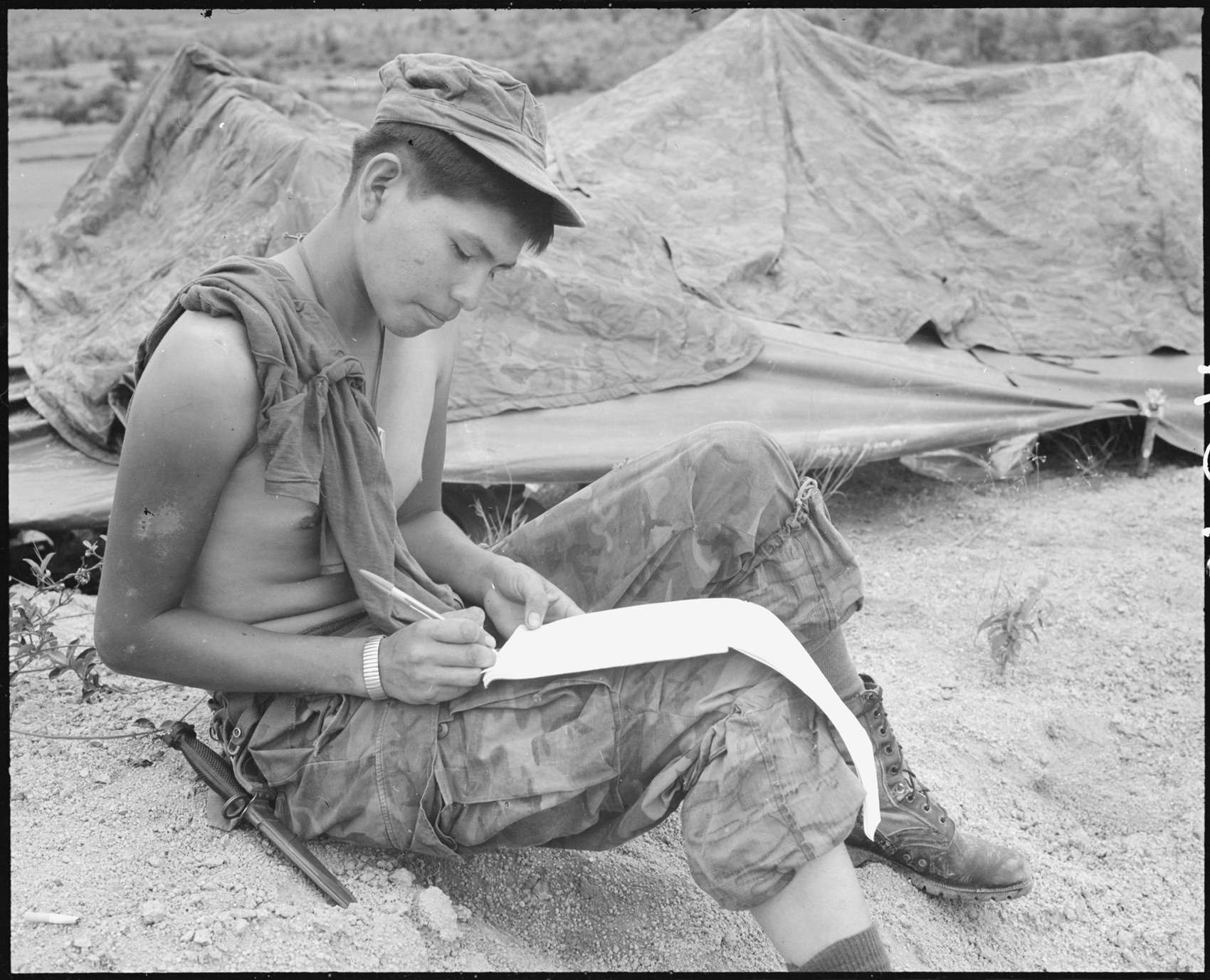
2
Activity Element
Rolling Thunder 53 Strike Map
Page 1
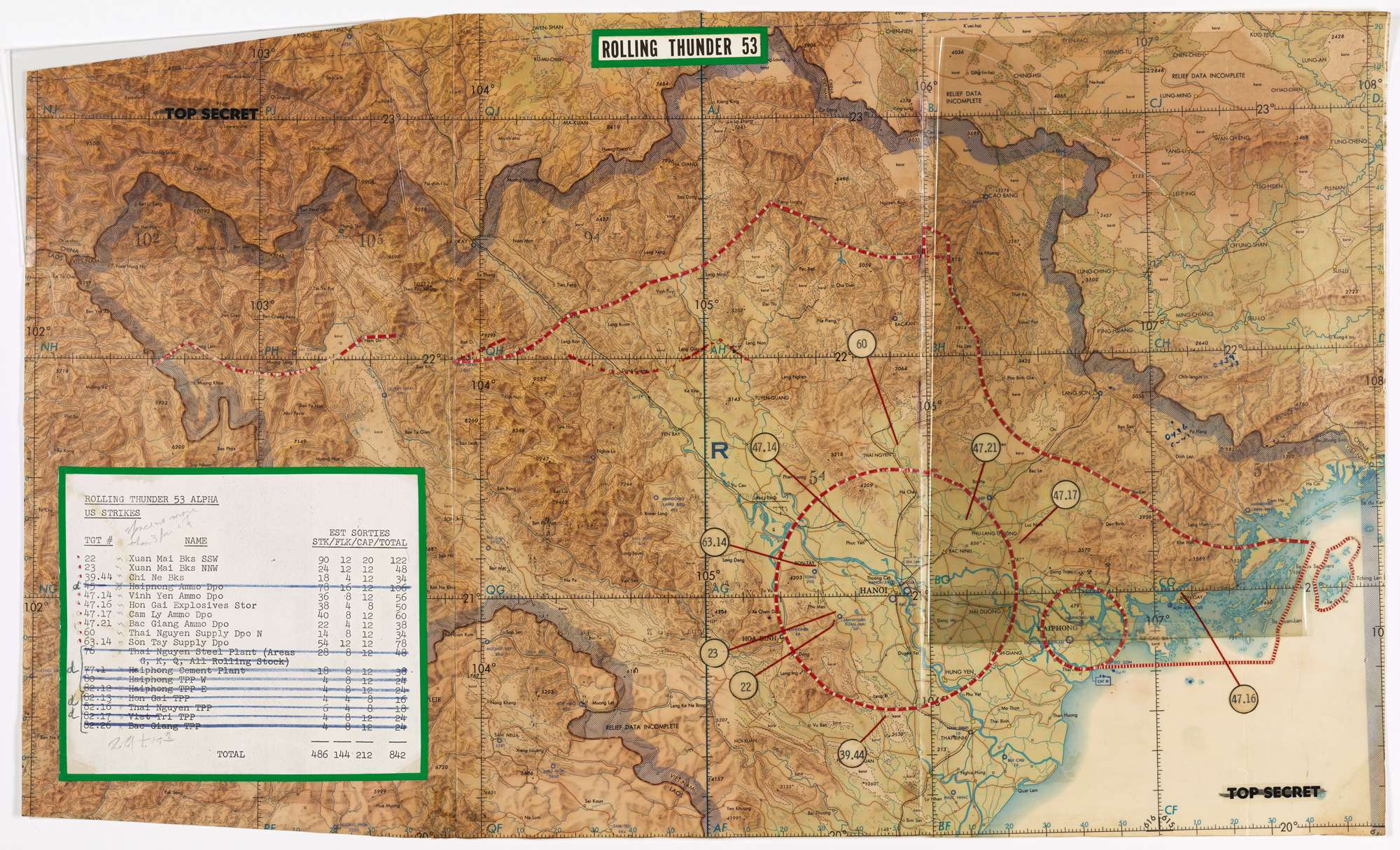
3
Activity Element
Vietnam. Defoliation Mission.
Page 1
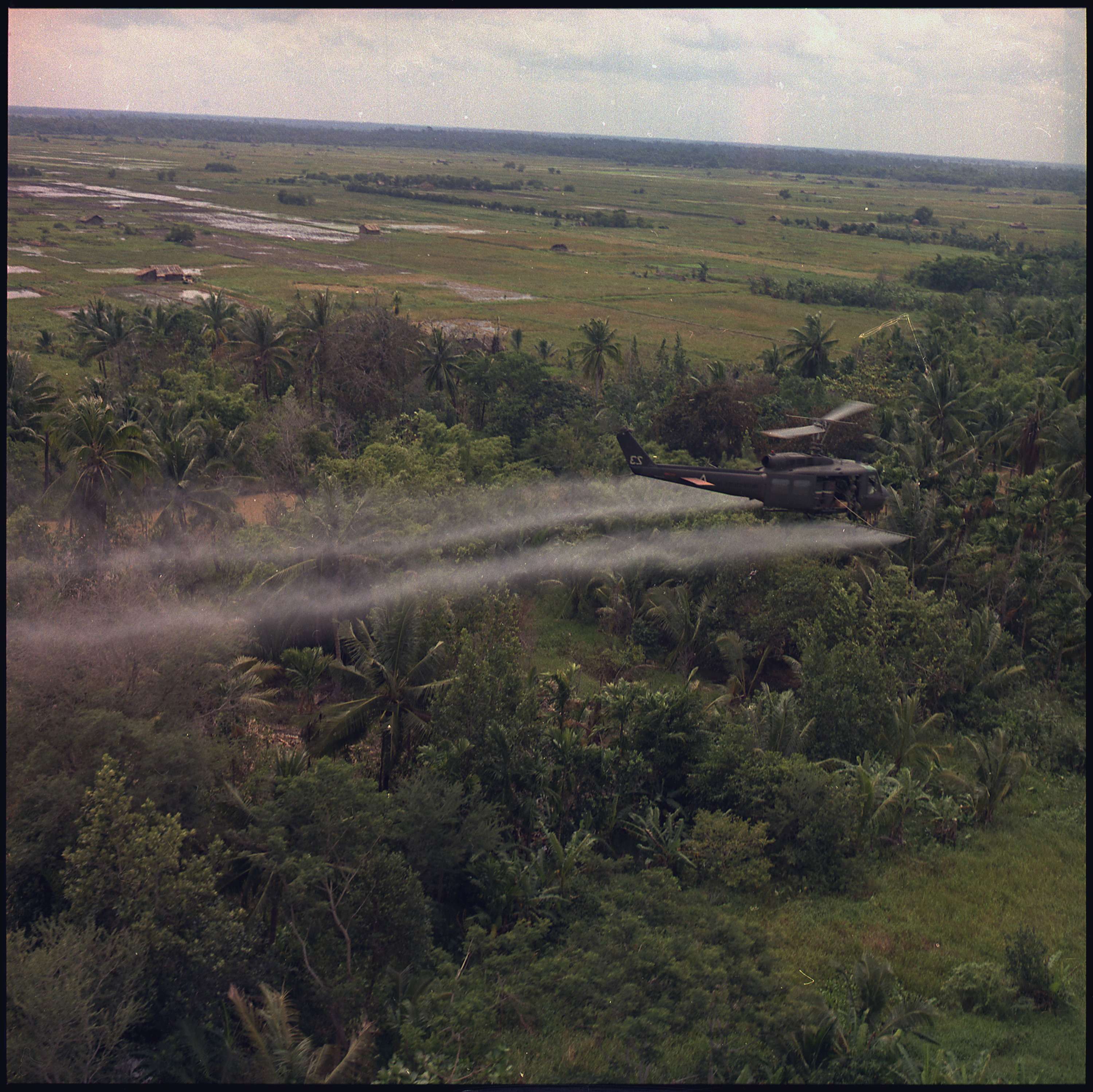
4
Activity Element
Photograph contact sheet, 2/7/1968, 1968-02-07-C8489
Page 1
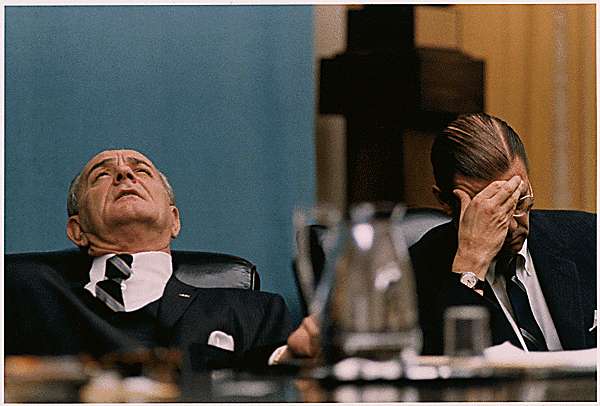
5
Activity Element
President Johnson`s Vietnam Address
Page 1

6
Activity Element
National Security Action Memorandum No. 115 Defoliant Operations in Vietnam
Page 1
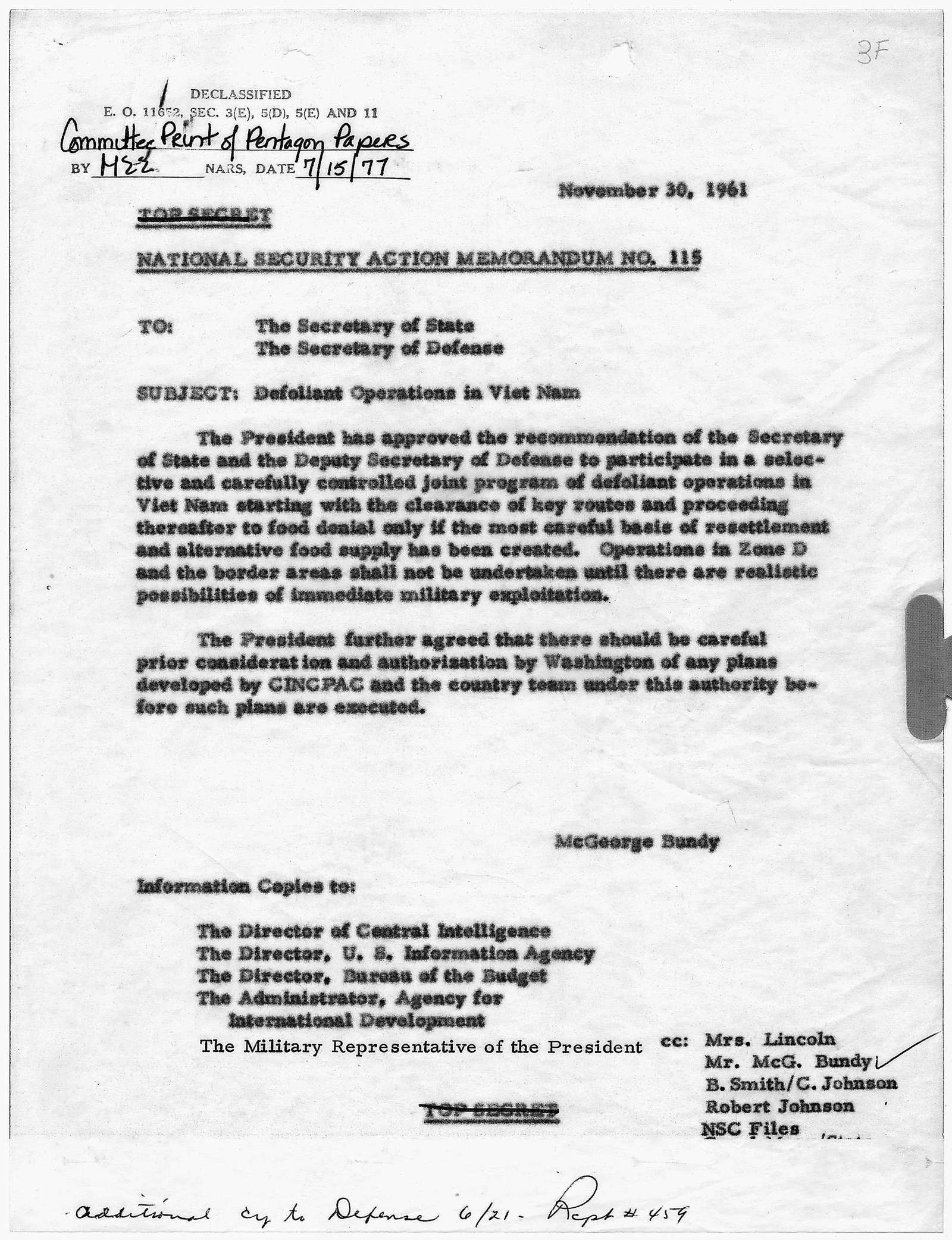
7
Activity Element
Public Reactions: The March on the Pentagon
Page 1
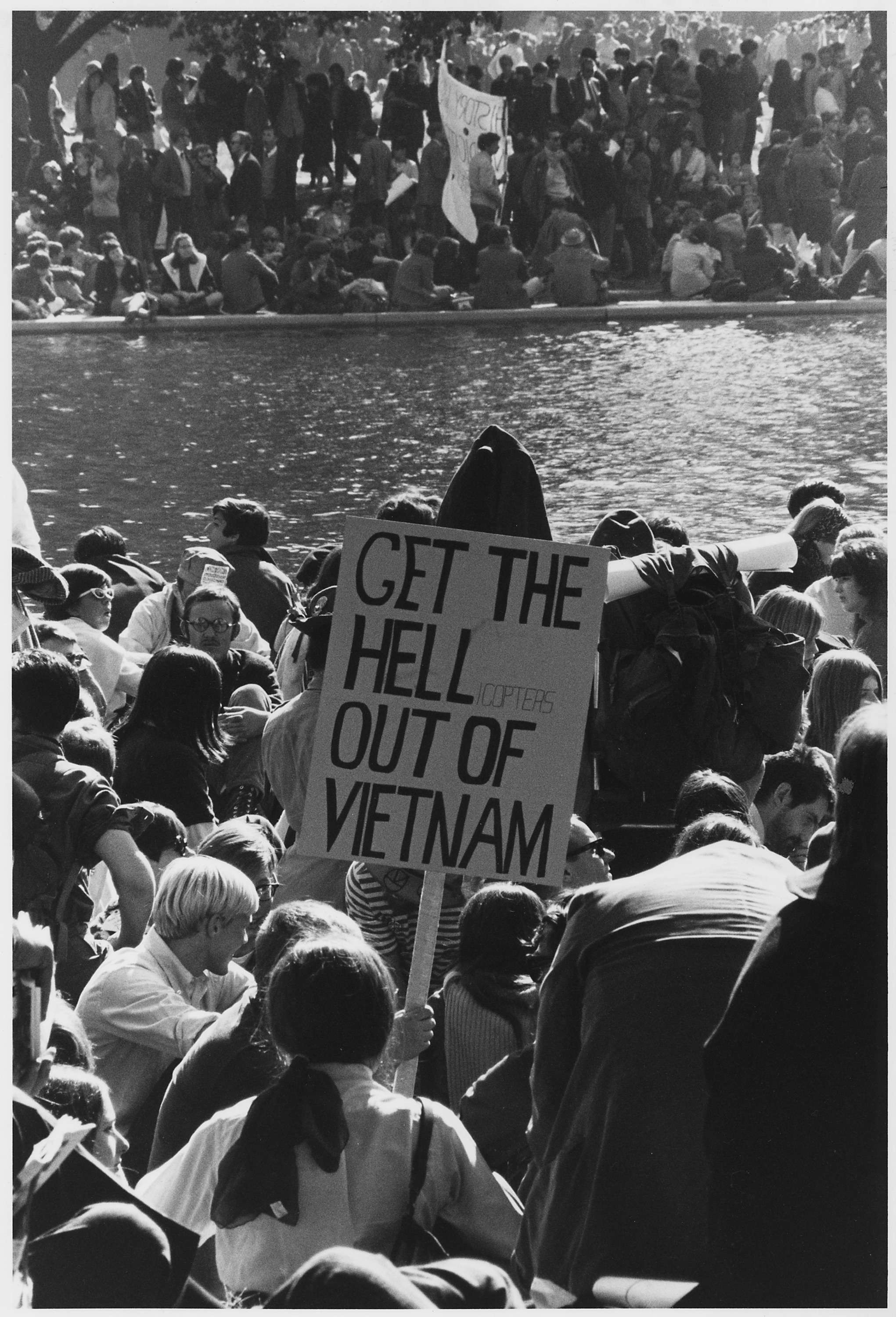
8
Activity Element
UH-1D Medevac Helicopter
Page 1

9
Activity Element
Operation Shelby—PFC Manuel Garcia (El Centro, Calif.) Rifleman, Co. E, 3rd Bn, 7th Inf, 199th Light Inf. Bde., Cleans His M–16 Rifle
Page 1
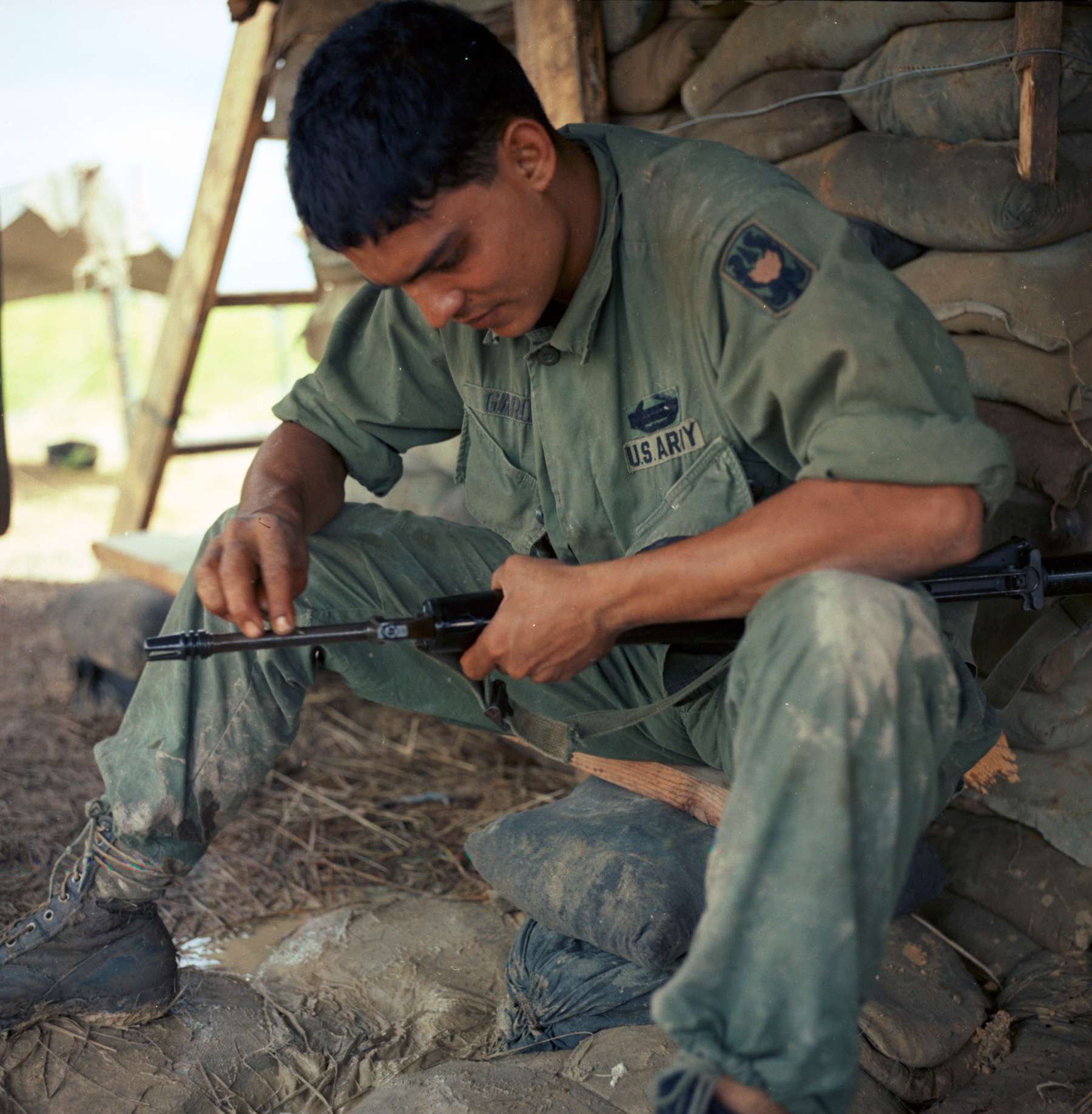
10
Activity Element
December 1966: Footage of President Johnson, Lady Bird, and Daughter Lynda Visiting with Combat Soldiers Wounded in Vietnam and on Their Way to Military Hospitals in the San Antonio, Texas Area.
Page 1
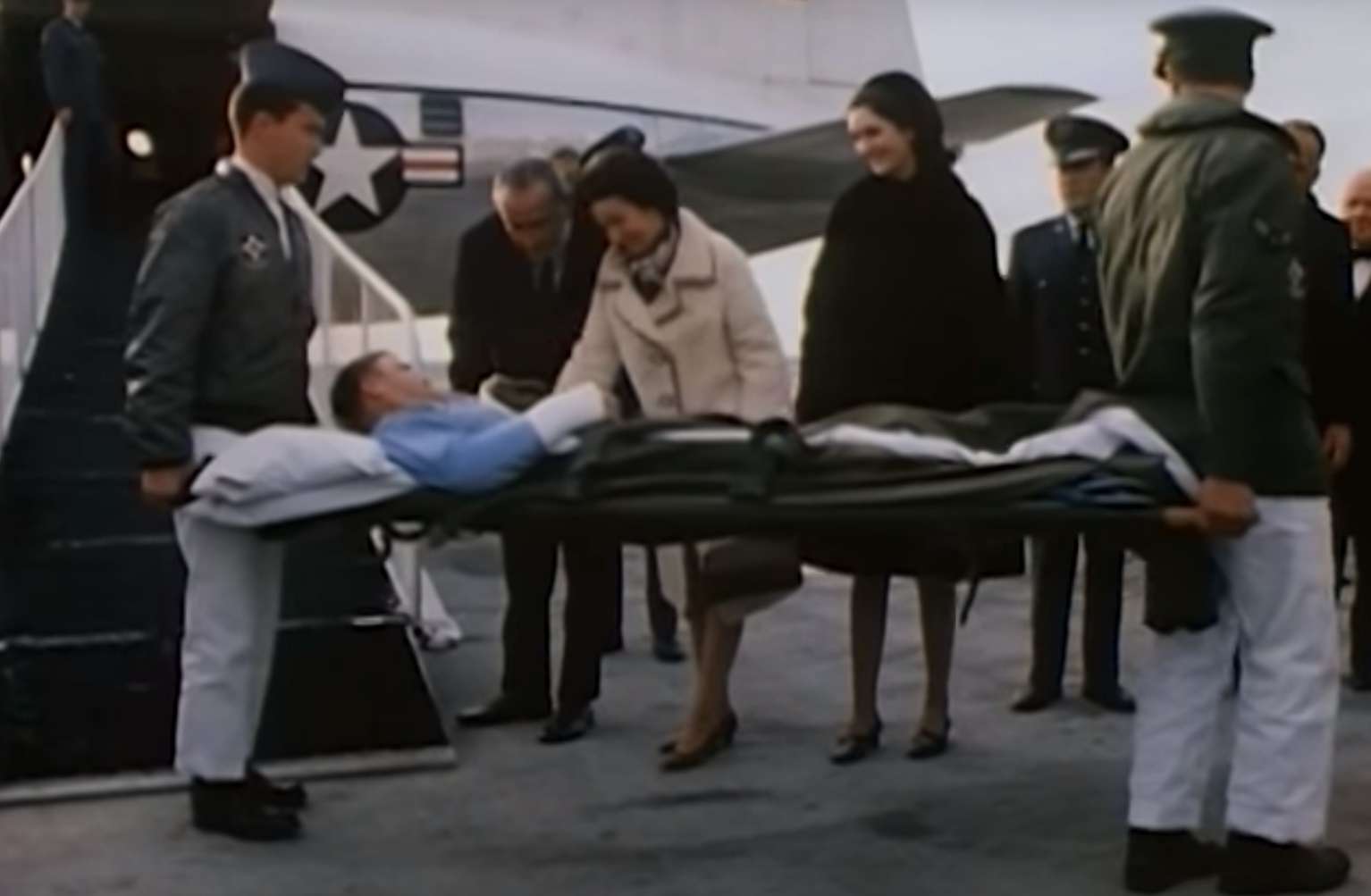
11
Activity Element
Draft Page Three of the Last Section of the March 31, 1968 Speech by Lyndon Johnson
Page 1
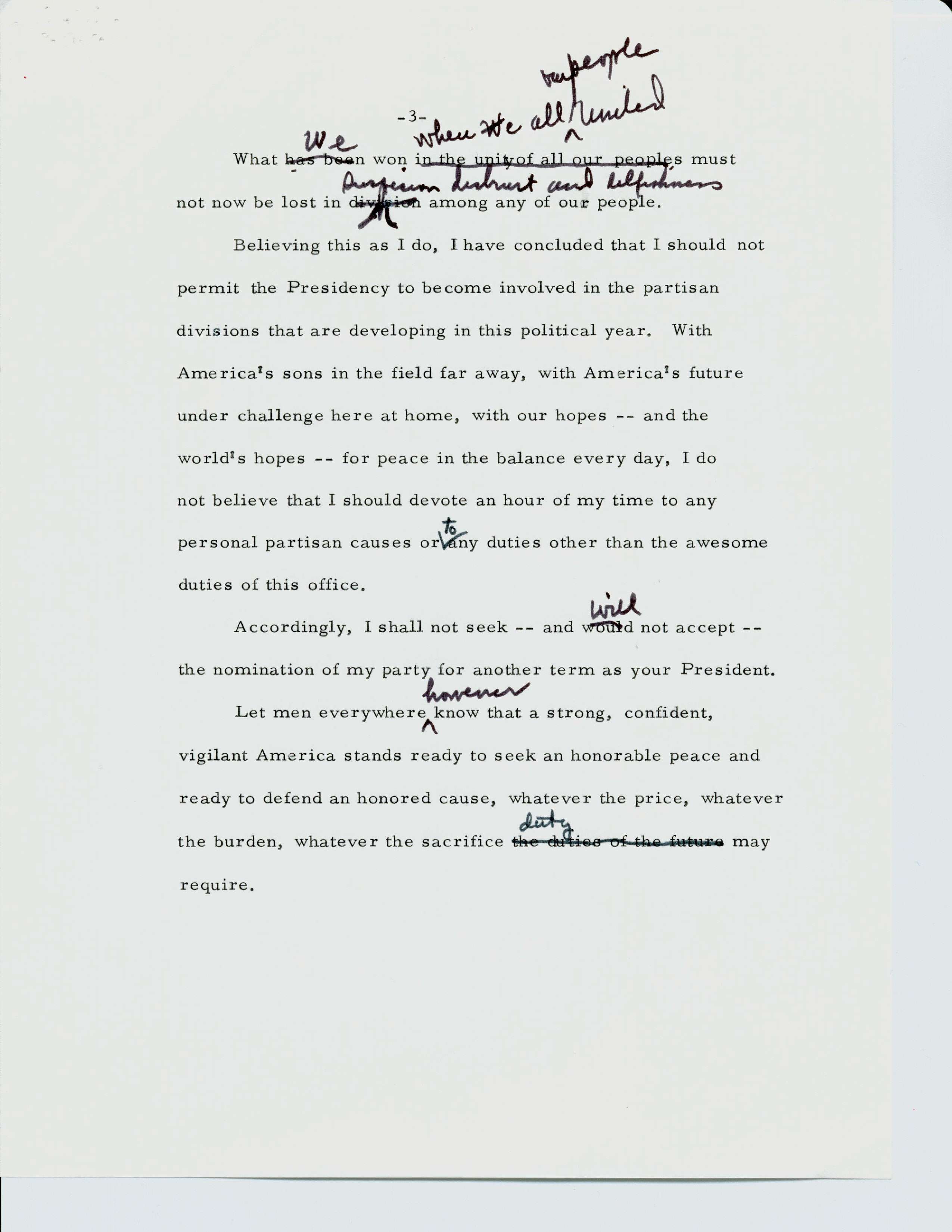
12
Activity Element
President Richard Nixon Points to a Map of Cambodia during a Vietnam War Press Conference
Page 1
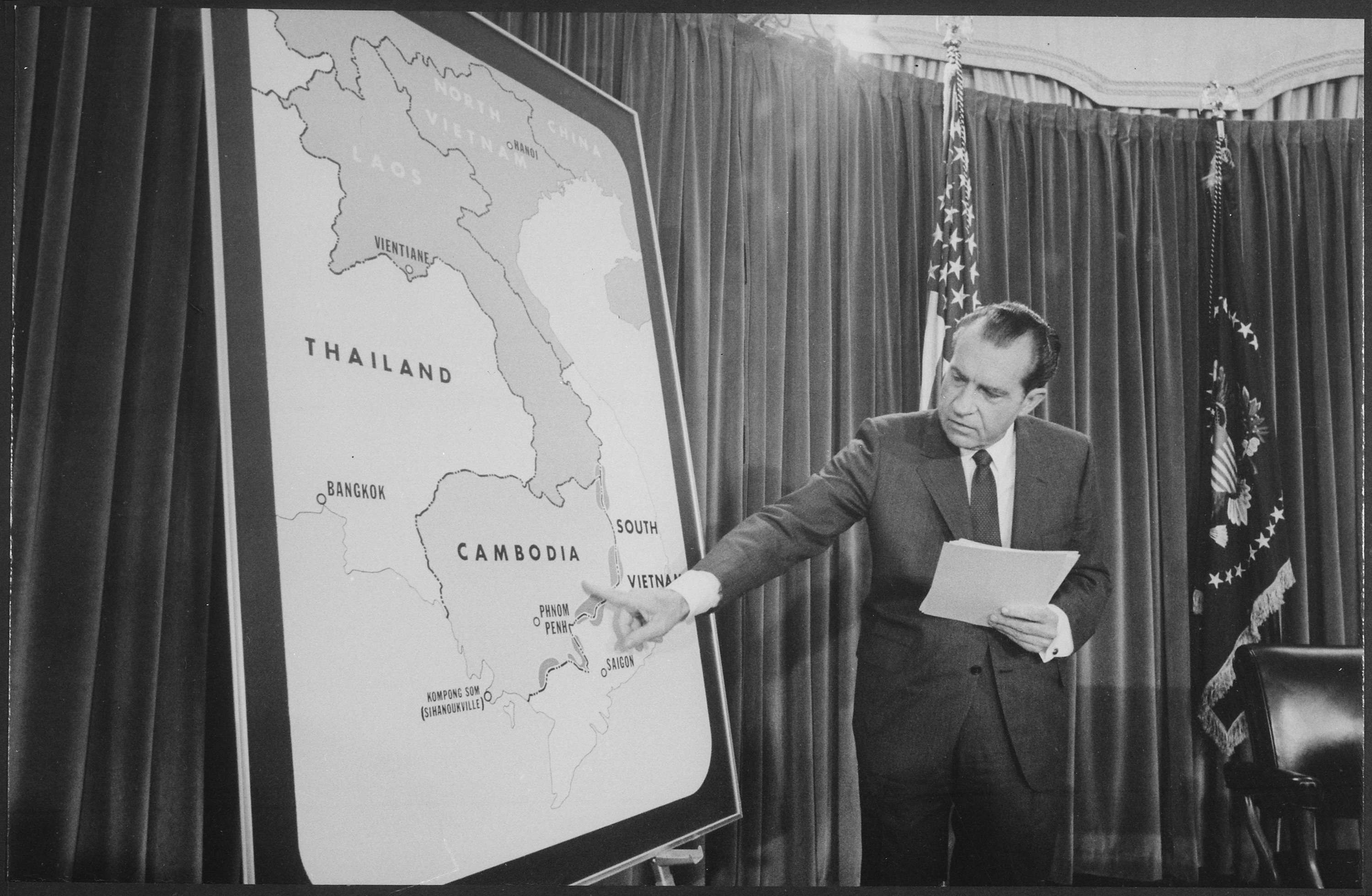
13
Activity Element
Richard Nixon in Chu Lai, South Vietnam
Page 1
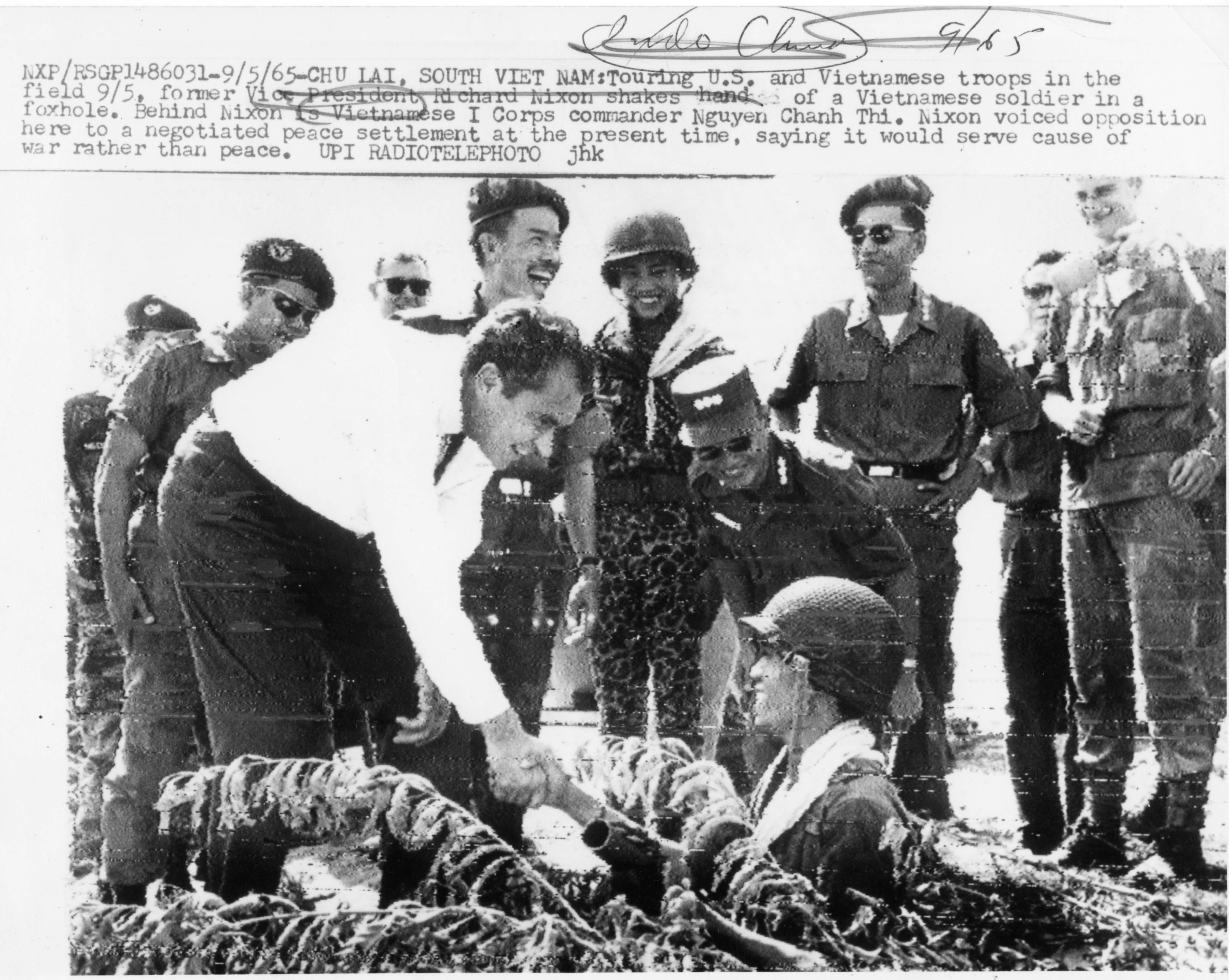
14
Activity Element
Viet Cong Prisoner
Page 1
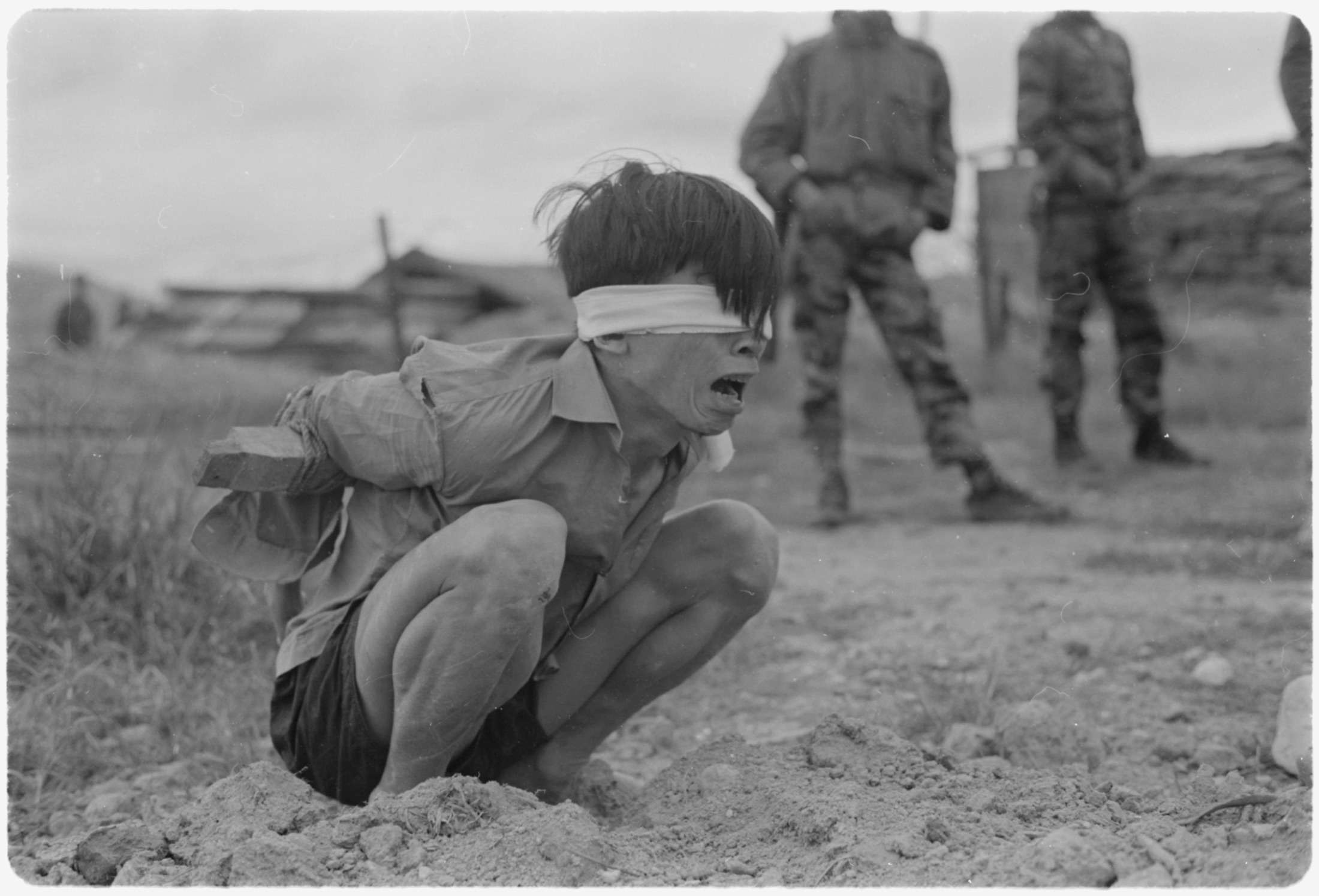
15
Activity Element
A Viet Cong Soldier Crouches in a Bunker with an SKS Rifle
Page 1
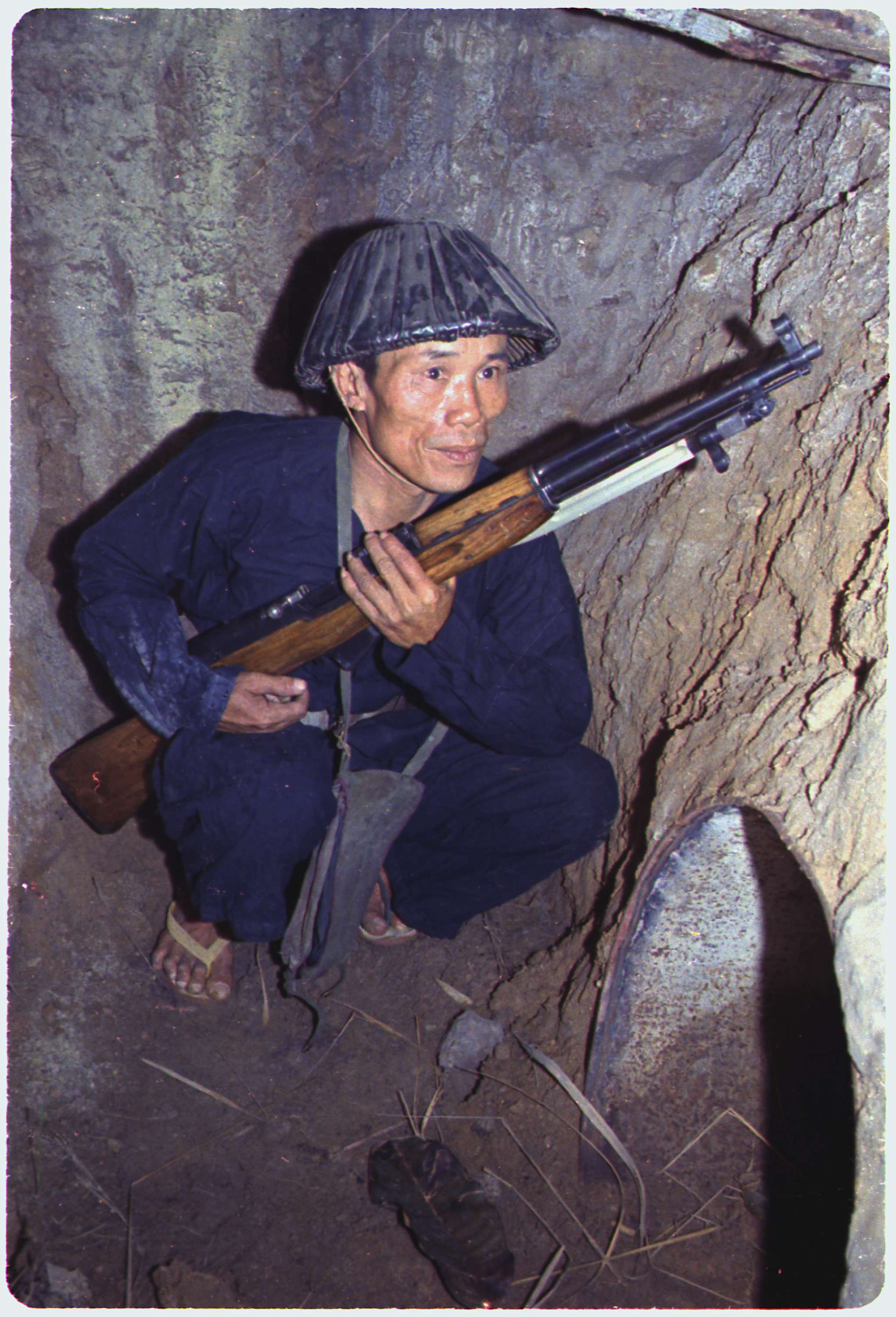
16
Activity Element
Arrival of the U.S. 1st Cavalry Division (Air Mobile) in Vietnam
Page 1
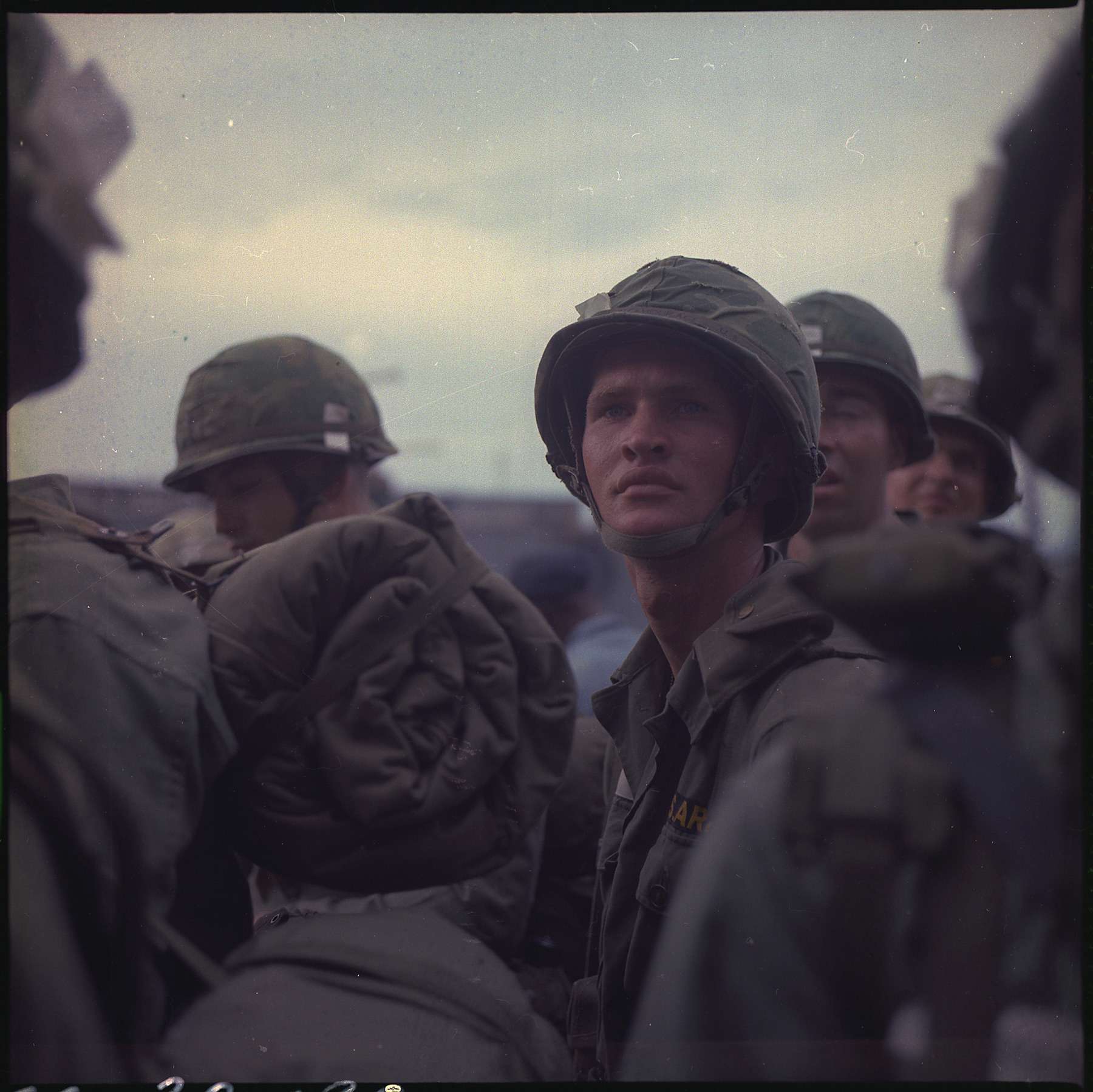
17
Activity Element
Sergeant Robert E. Fears
Page 1
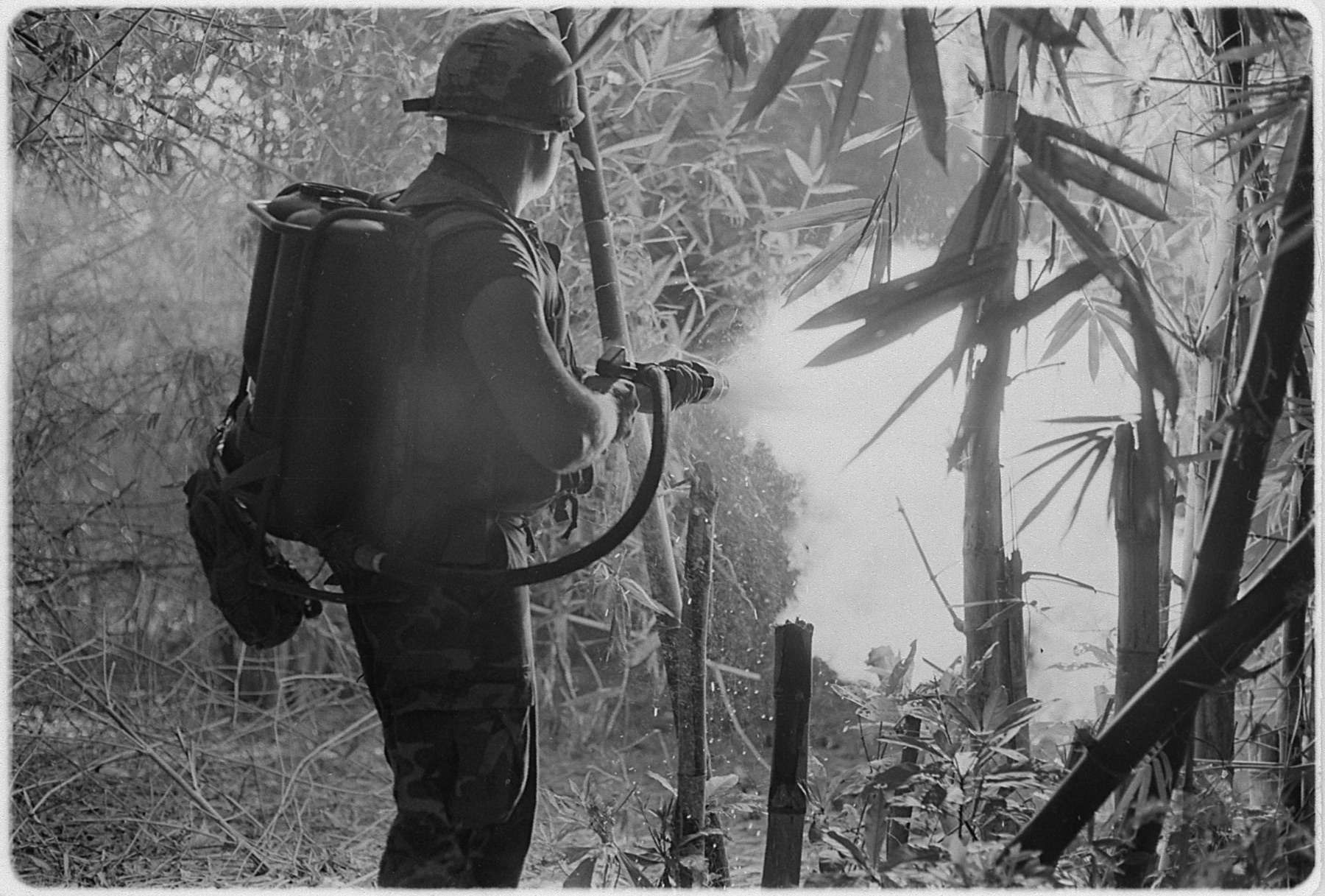
18
Activity Element
Certification of the 26th Amendment
Page 1

19
Activity Element
Statement by the President on Evacuation of American Personnel from South Viet Nam [Ford Speech or Statement]
Page 1

20
Activity Element
313 - ARVN (Army of the Republic of Vietnam) - 1968 - July 28, 1968
Page 1
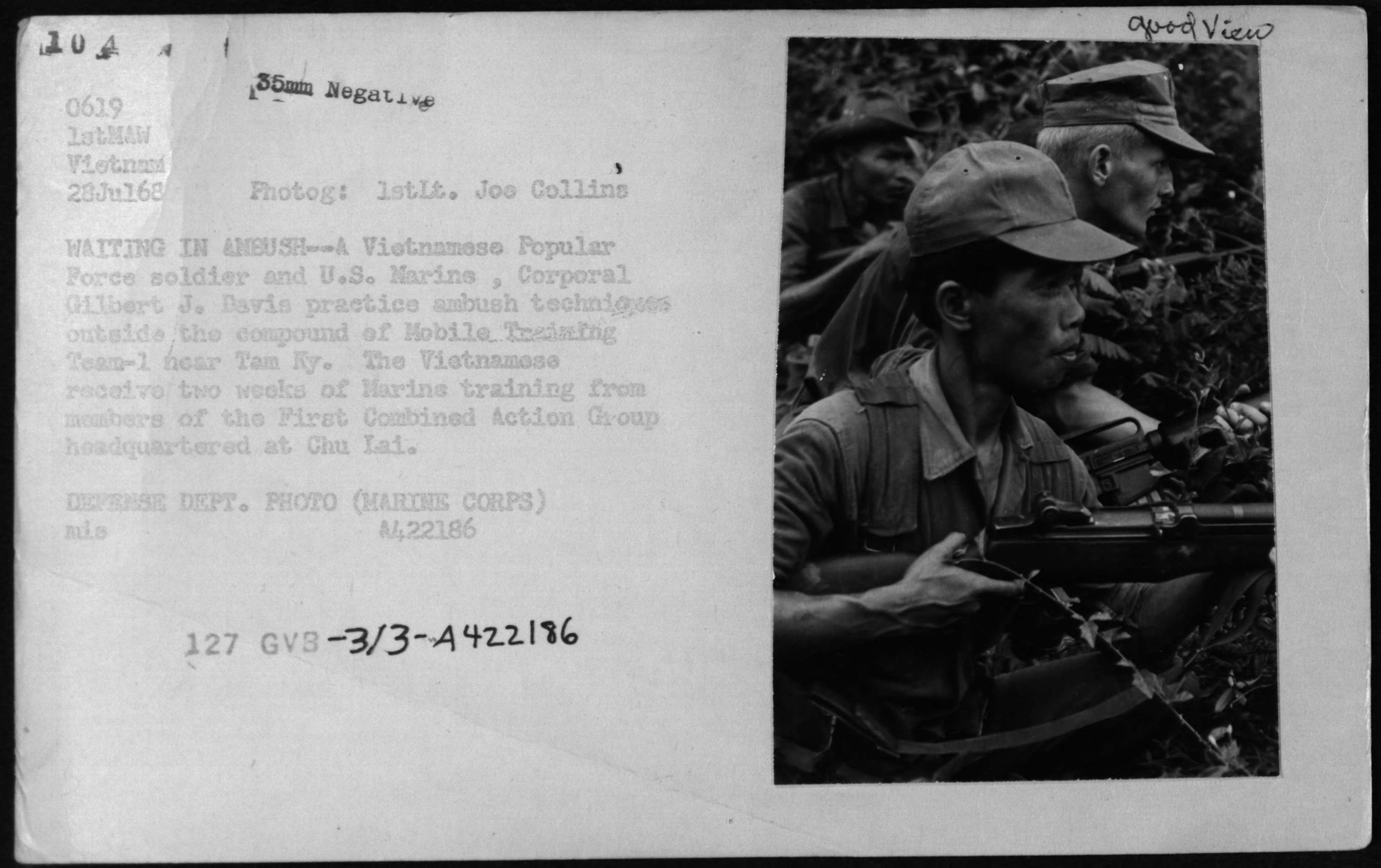
21
Activity Element
First Tonkin Gulf Incident
Page 1
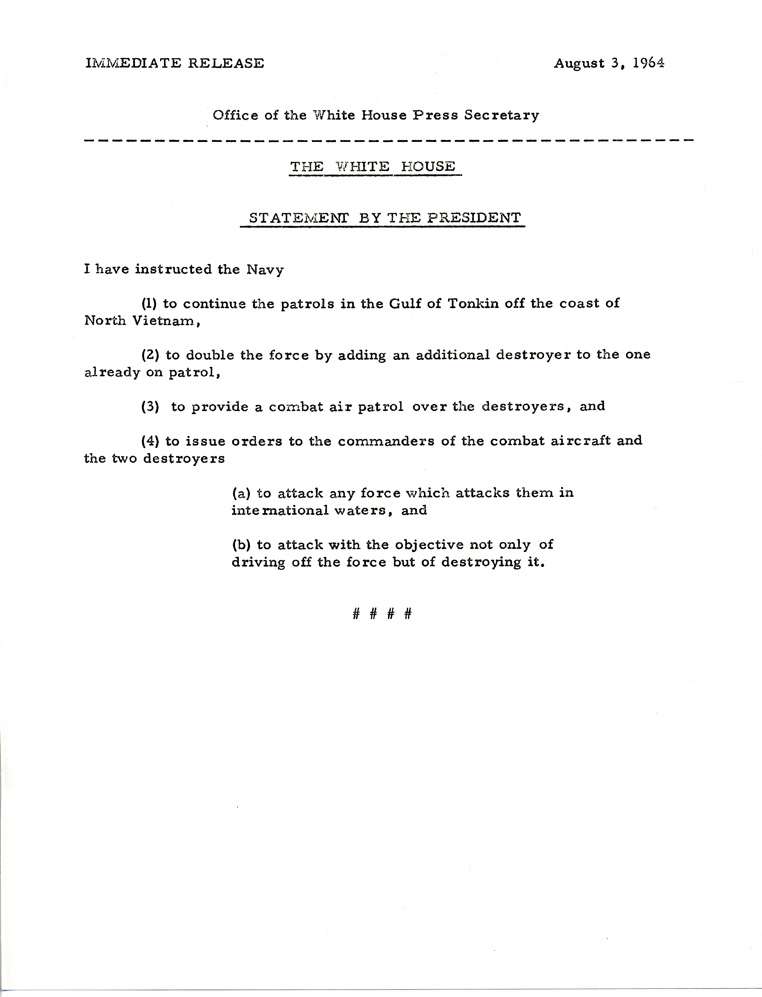
22
Activity Element
Army Behavior Poster (7 Panels to set) - Vietnamese Army`s Seven Commandments
Page 1

23
Activity Element
Memorandum Notifying President Johnson of Attack on the U.S.S. Maddox
Page 1

24
Activity Element
State Department Telegram Text of a Letter from Ho Chi Minh to President Johnson
Page 1
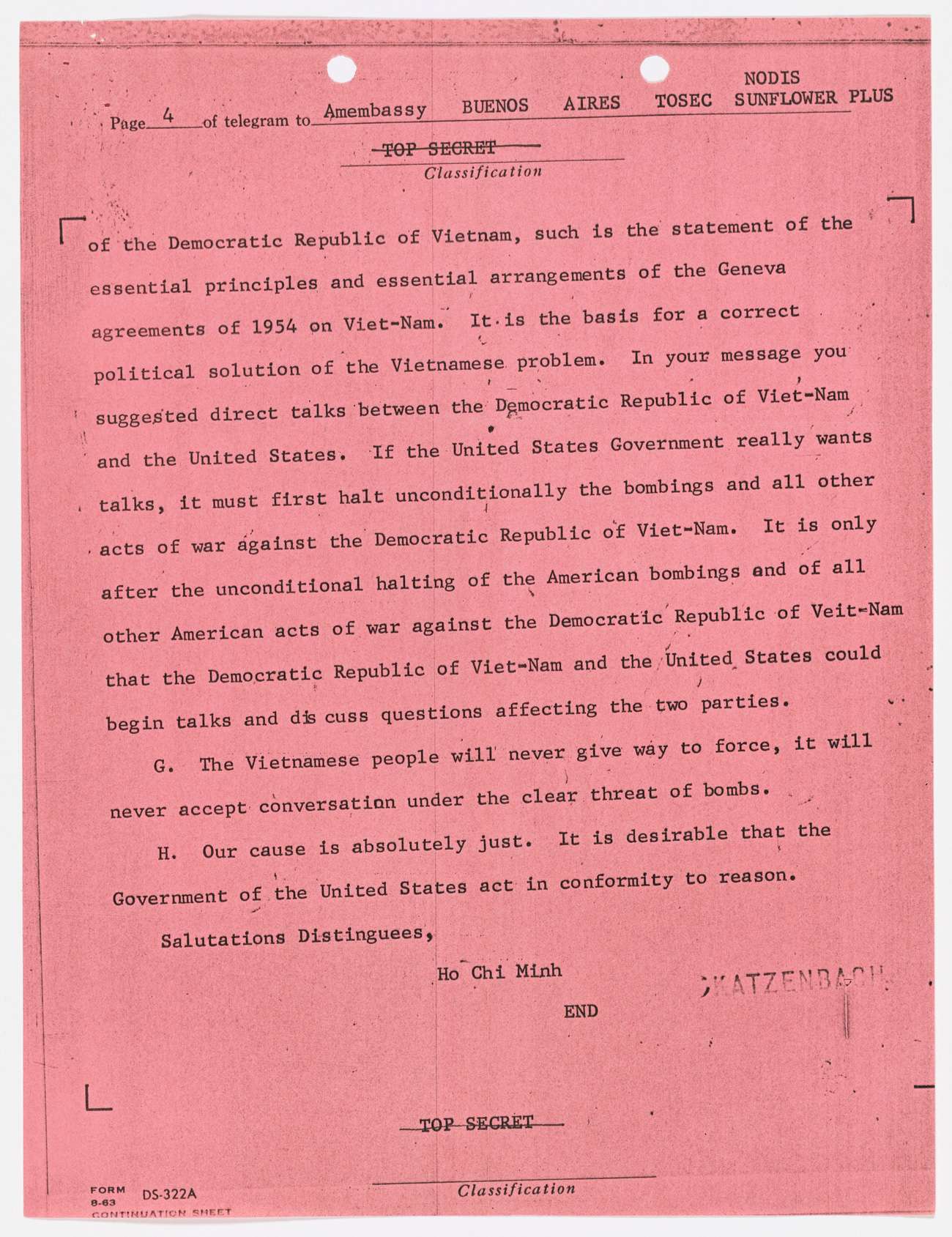
25
Activity Element
Letter from Mrs. Keck to President Johnson Regarding her Son's Death
Page 1

26
Activity Element
Napalm bombs explode on Viet Cong structures south of Saigon in the Republic of Vietnam
Page 1
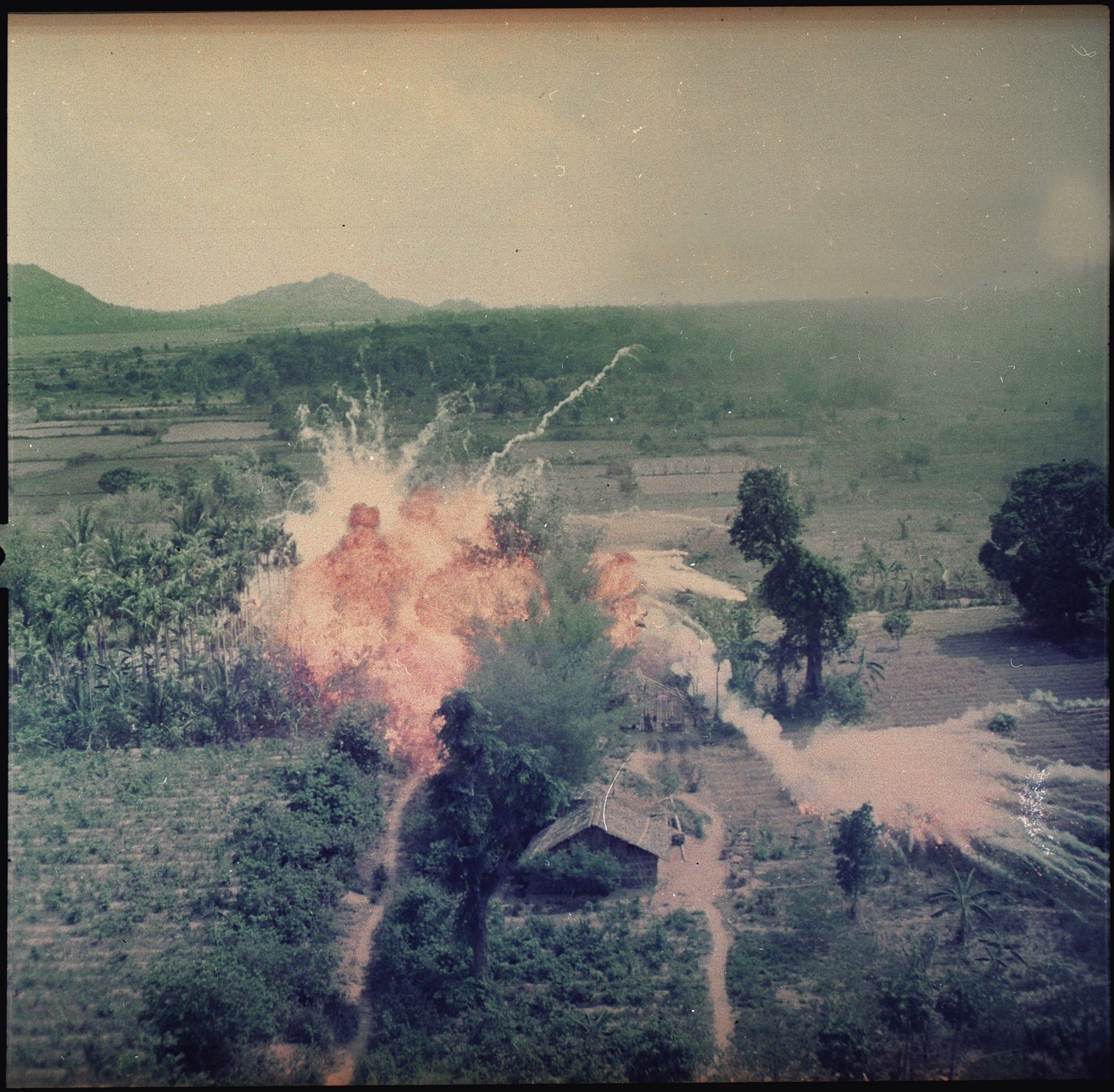
27
Activity Element
Defendants` Exhibit 2 in John F. Tinker et. al. v. The Des Moines Independent Community School District et. al.
Page 1

28
Activity Element
Joint Resolution of August 10, 1964, Public Law 88-408, 78 STAT 384, to Promote the Maintenance of International Peace and Security in Southeast Asia
Page 1

29
Activity Element
Memo from Walt W. Rostow to President Johnson
Page 1

30
Activity Element
314 - ARVN (Army of the Republic of Vietnam) - 1969
Page 1
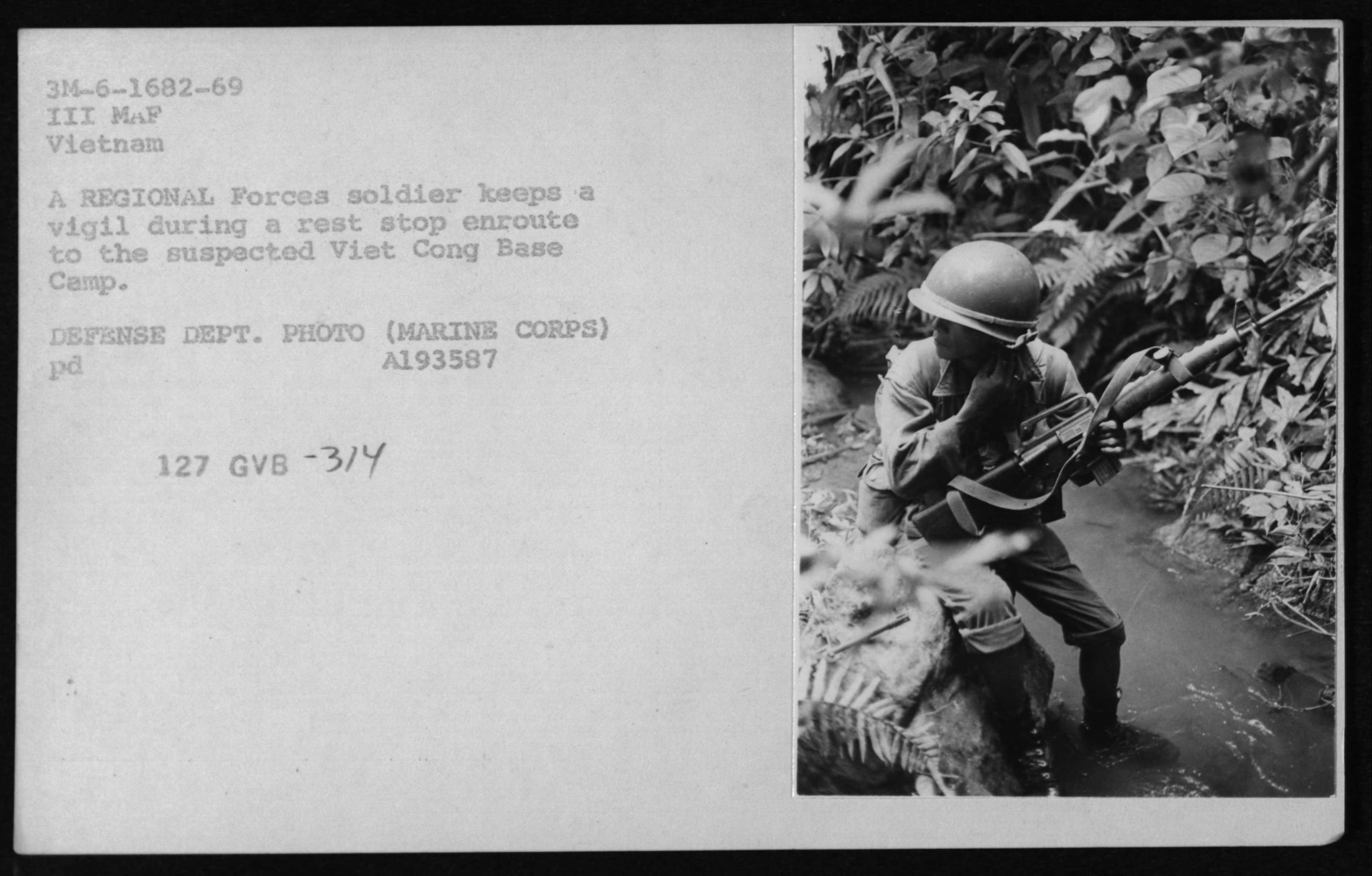
Conclusion
Vietnam War Timeline
Finding a Sequence
Answer the following questions based on the primary sources in your timeline:1a. What event caused the United States to increase their military involvement in Vietnam?
1b. What document or law gave President Johnson the authority to escalate the U.S. involvement in Vietnam?
2. What were the major events of the Vietnam War? State each major event with a short description of it (one sentence or less).
3. The geography of Vietnam was very different from any previous war the United States had fought in. Technology was therefore used to help overcome geographic difficulties. Using the documents in the activity, explain the technologies used in the war to aid fighting.
4. President Johnson decided not to run for re-election in 1968. Why do you think he made this decision? Would you make the same decision? Explain your thinking.
5. Based on the pictures in the activity, what was life like for the soldiers fighting in the war? What challenges do you think they faced as they fought?
Your Response
Document
Arrival of the U.S. 1st Cavalry Division (Air Mobile) in Vietnam
9/14/1965
The 15,800 men and 424 Helicopters and Planes disembarked from troopships and carriers at Qui Nhon and then immediately moved inland by air and convoy to their assigned tactical operations area at An Khe. Men of the 1st Battalion, 77th Artillery watches from the lou as their comrades in arms disembark from the troop transport USNS General Simon Buckner.
This primary source comes from the Records of the Office of the Chief Signal Officer.
National Archives Identifier: 530609
Full Citation: Photograph 111-C-CC32090; Arrival of the U.S. 1st Cavalry Division (Air Mobile) in Vietnam; 9/14/1965; Color Photographs of Signal Corps Activity, 1944 - 1981; Records of the Office of the Chief Signal Officer, ; National Archives at College Park, College Park, MD. [Online Version, https://docsteach.org/documents/document/arrival-of-air-mobile-vietnam, April 19, 2024]Arrival of the U.S. 1st Cavalry Division (Air Mobile) in Vietnam
Page 1
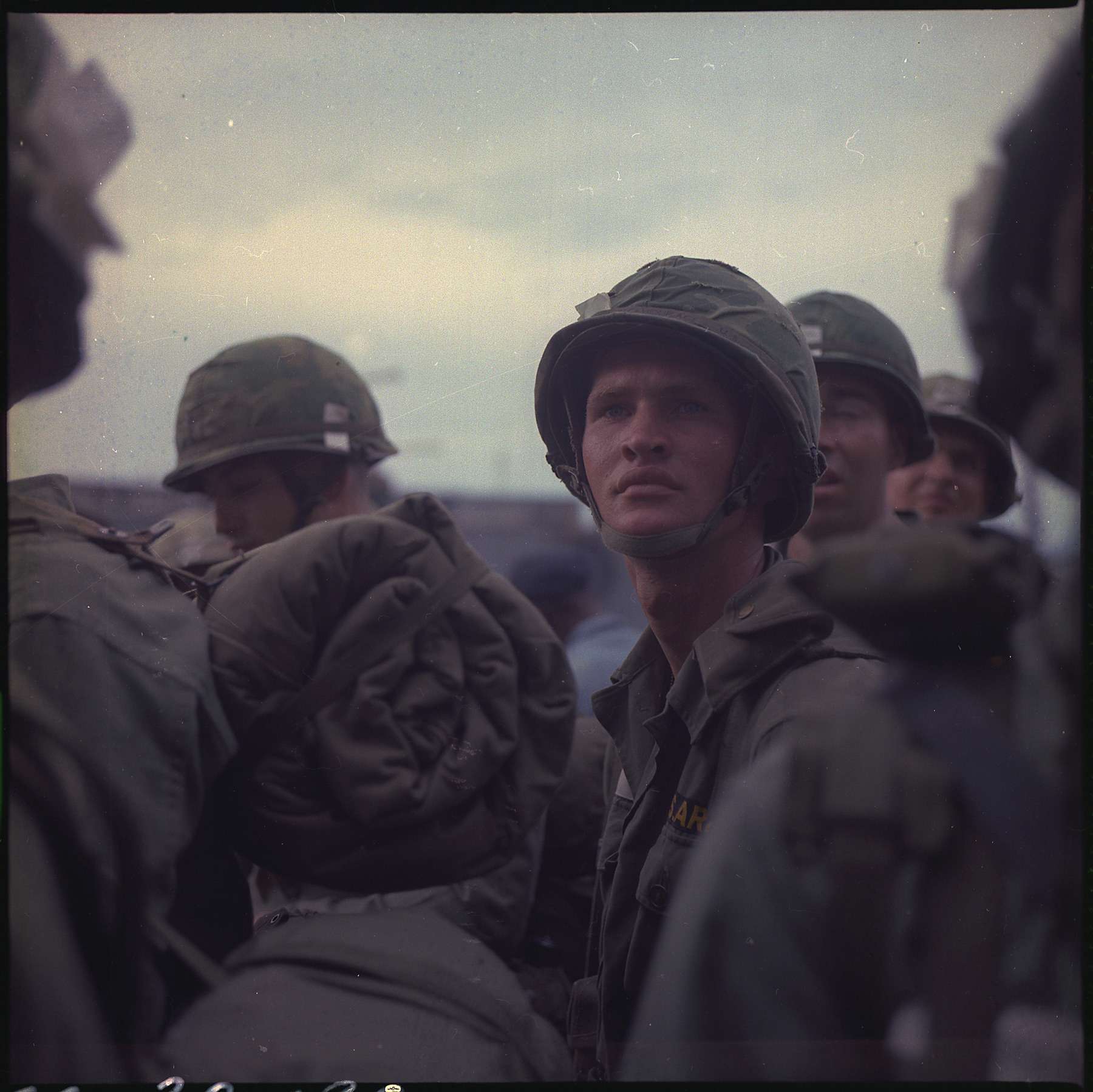
Document
Sergeant Robert E. Fears
5/22/1970
Da Nang, Vietnam. Sergeant Robert E. Fears clears an area using his flamethrower.
This primary source comes from the Records of the U.S. Marine Corps.
National Archives Identifier: 532491
Full Citation: Photograph 127-N-A374071; Sergeant Robert E. Fears; 5/22/1970; General Photograph File of the U.S. Marine Corps, 1927 - 1981; Records of the U.S. Marine Corps, ; National Archives at College Park, College Park, MD. [Online Version, https://docsteach.org/documents/document/sergeant-fears, April 19, 2024]Sergeant Robert E. Fears
Page 1
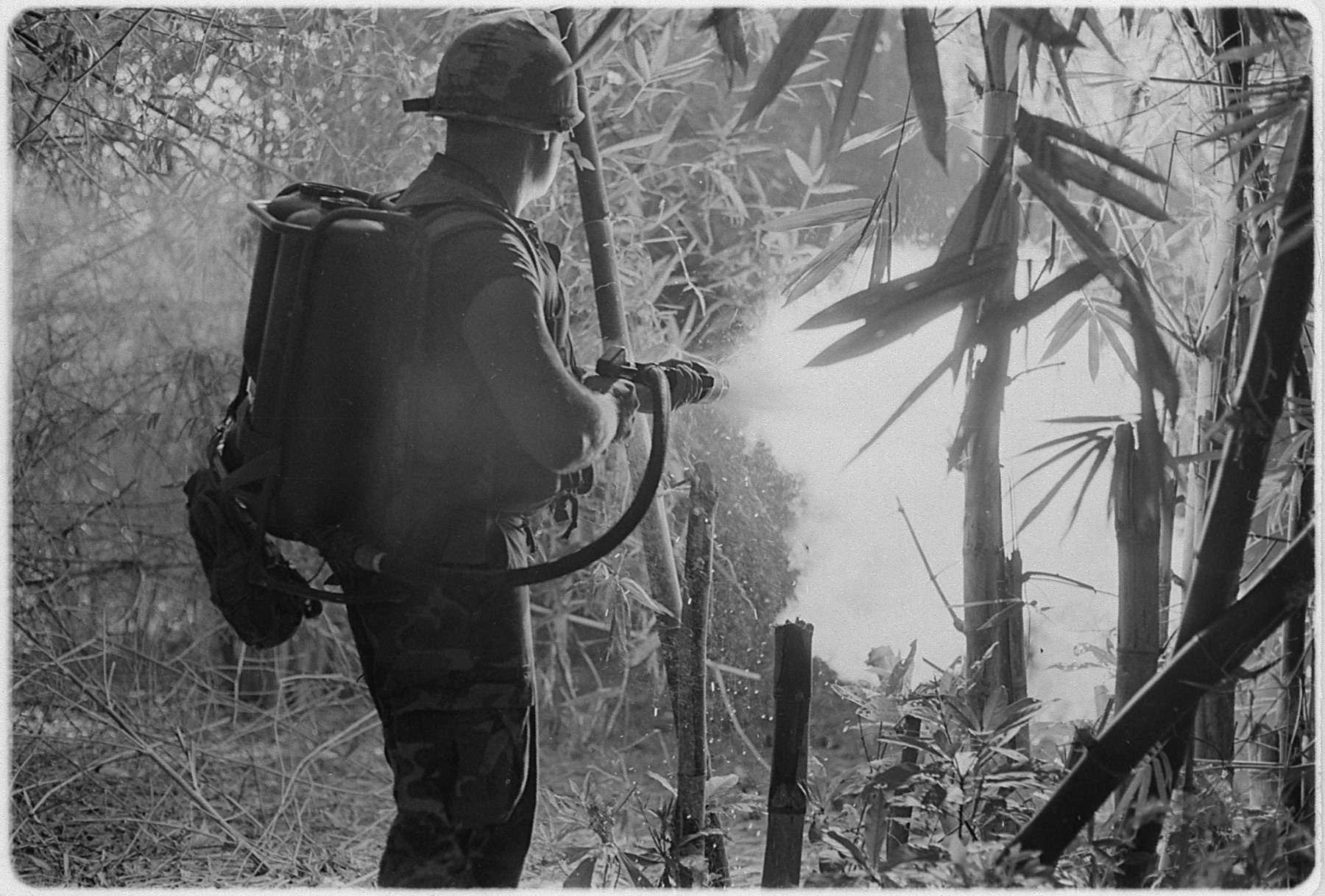
Document
Army Behavior Poster (7 Panels to set) - Vietnamese Army's Seven Commandments
5/28/1956
This propaganda poster comes from a series of army behavior posters used during the Vietnam War. It says “You must be close to the people, protect the people and help the people.”
American advisers counseled the South Vietnamese Army (ARVN) to stop running over farmers’ chickens with their trucks and be more considerate of the people they were charged with protecting. The ARVN had to overcome cultural differences with the rural population, as well as suspicion over its former association with the French colonizers.
American advisers counseled the South Vietnamese Army (ARVN) to stop running over farmers’ chickens with their trucks and be more considerate of the people they were charged with protecting. The ARVN had to overcome cultural differences with the rural population, as well as suspicion over its former association with the French colonizers.
This primary source comes from the Records of the U.S. Information Agency.
National Archives Identifier: 6948908
Full Citation: Poster 306-PPB-79g; Army Behavior Poster (7 Panels to set) - Vietnamese Army's Seven Commandments; 5/28/1956; Propaganda Posters Distributed in Asia, Latin America and the Middle East, ca. 1950 - ca. 1965; Records of the U.S. Information Agency, ; National Archives at College Park, College Park, MD. [Online Version, https://docsteach.org/documents/document/vietnamese-army-commandment-7, April 19, 2024]Army Behavior Poster (7 Panels to set) - Vietnamese Army's Seven Commandments
Page 1
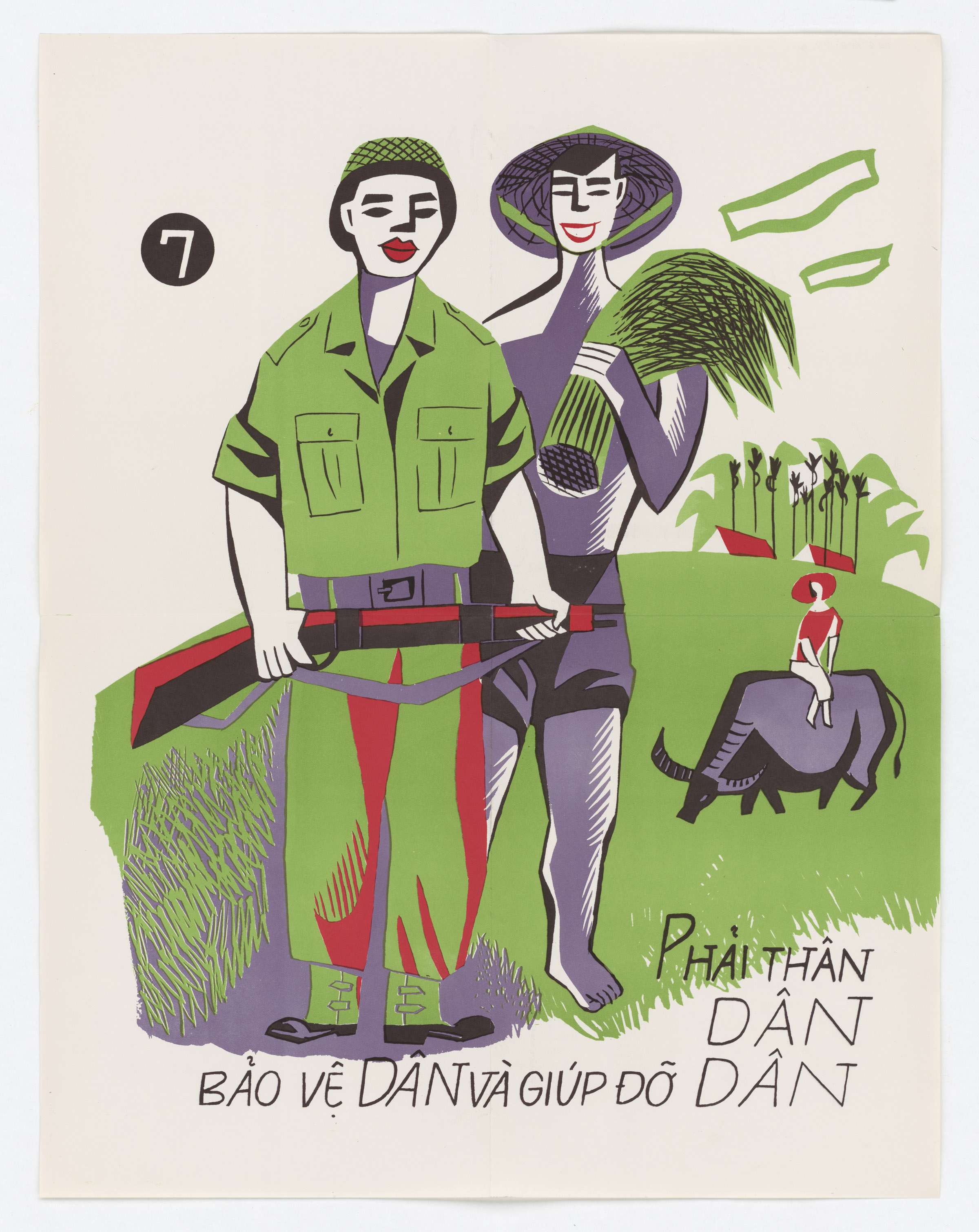
Document
Joint Resolution of August 10, 1964, Public Law 88-408, 78 STAT 384, to Promote the Maintenance of International Peace and Security in Southeast Asia
8/10/1964
This is Public Law 88-408, Joint Resolution for the Maintenance of Peace and Security in Southeast Asia, that was passed by Congress and signed by President Lyndon B. Johnson. This is a "ceremonial copy" of the Public Law from the Lyndon B. Johnson Museum Collection.
Congress passed the Tonkin Gulf Resolution with the understanding that U.S. ships had been attacked twice in international waters in the Gulf of Tonkin near North Vietnam. They gave Johnson unprecedented power to “take all necessary measures to repel any armed attack against the forces of the United States and to prevent further aggression.”
There was little debate as legislators considered two incidents that had happened in the preceding days. On August 2 – the first Tonkin Gulf incident – North Vietnamese torpedo boats were spotted and attacked the destroyer USS Maddox. The Maddox was conducting electronic eavesdropping on North Vietnam to assist South Vietnamese Army (ARVN) commando raids on North Vietnamese targets, but that wasn't publicly known at the time. Historians now suspect the North Vietnamese boats had set out to attack an ARVN raid in progress when it encountered the Maddox.
On August 4, the USS Maddox captain reported a second incident, that he was “under continuous torpedo attack.” He later cabled “freak weather effects on radar and overeager sonarmen may have accounted for many reports,” but Defense Secretary Robert McNamara did not report the captain’s doubts to President Johnson. (A 2002 National Security Agency report made available in 2007 confirmed the August 2 attack, but concluded the August 4 attack never happened.)
Johnson portrayed confrontations between U.S. and North Vietnamese ships off the coast of North Vietnam as unprovoked aggression. When contrary information surfaced, many believed Congress had been conned. It was too late.
The Gulf of Tonkin act became more controversial as opposition to the war mounted. A Senate investigation revealed that the Maddox had been on an intelligence mission in Tonkin Gulf, contradicting Johnson’s denial of U.S. Navy support of such missions. The Resolution was repealed in 1971 in an attempt to curtail President Nixon’s power to continue the war.
Congress passed the Tonkin Gulf Resolution with the understanding that U.S. ships had been attacked twice in international waters in the Gulf of Tonkin near North Vietnam. They gave Johnson unprecedented power to “take all necessary measures to repel any armed attack against the forces of the United States and to prevent further aggression.”
There was little debate as legislators considered two incidents that had happened in the preceding days. On August 2 – the first Tonkin Gulf incident – North Vietnamese torpedo boats were spotted and attacked the destroyer USS Maddox. The Maddox was conducting electronic eavesdropping on North Vietnam to assist South Vietnamese Army (ARVN) commando raids on North Vietnamese targets, but that wasn't publicly known at the time. Historians now suspect the North Vietnamese boats had set out to attack an ARVN raid in progress when it encountered the Maddox.
On August 4, the USS Maddox captain reported a second incident, that he was “under continuous torpedo attack.” He later cabled “freak weather effects on radar and overeager sonarmen may have accounted for many reports,” but Defense Secretary Robert McNamara did not report the captain’s doubts to President Johnson. (A 2002 National Security Agency report made available in 2007 confirmed the August 2 attack, but concluded the August 4 attack never happened.)
Johnson portrayed confrontations between U.S. and North Vietnamese ships off the coast of North Vietnam as unprovoked aggression. When contrary information surfaced, many believed Congress had been conned. It was too late.
The Gulf of Tonkin act became more controversial as opposition to the war mounted. A Senate investigation revealed that the Maddox had been on an intelligence mission in Tonkin Gulf, contradicting Johnson’s denial of U.S. Navy support of such missions. The Resolution was repealed in 1971 in an attempt to curtail President Nixon’s power to continue the war.
Transcript
Eighty-eighth Congress of the United States of AmericaAT THE SECOND SESSION
Begun and held at the City of Washington on Tuesday, the seventh day of January, one thousand nine hundred and sixty-four
Joint Resolution
To promote the maintenance of international peace and security in southeast Asia.
Whereas naval units of the Communist regime in Vietnam, in violation of the principles of the Charter of the United Nations and of international law, have deliberately and repeatedly attacked United States naval vessels lawfully present in international waters, and have thereby created a serious threat to international peace; and
Whereas these attackers are part of deliberate and systematic campaign of aggression that the Communist regime in North Vietnam has been waging against its neighbors and the nations joined with them in the collective defense of their freedom; and
Whereas the United States is assisting the peoples of southeast Asia to protest their freedom and has no territorial, military or political ambitions in that area, but desires only that these people should be left in peace to work out their destinies in their own way: Now, therefore be it
Resolved by the Senate and House of Representatives of the United States of America in Congress assembled, That the Congress approves and supports the determination of the President, as Commander in Chief, to take all necessary measures to repel any armed attack against the forces of the United States and to prevent further aggression.
Section 2. The United States regards as vital to its national interest and to world peace the maintenance of international peace and security in southeast Asia. Consonant with the Constitution of the United States and the Charter of the United Nations and in accordance with its obligations under the Southeast Asia Collective Defense Treaty, the United States is, therefore, prepared, as the President determines, to take all necessary steps, including the use of armed force, to assist any member or protocol state of the Southeast Asia Collective Defense Treaty requesting assistance in defense of its freedom.
Section 3. This resolution shall expire when the President shall determine that the peace and security of the area is reasonably assured by international conditions created by action of the United Nations or otherwise, except that it may be terminated earlier by concurrent resolution of the Congress.
[endorsements]
This primary source comes from the General Records of the United States Government.
National Archives Identifier: 2803448
Full Citation: Joint Resolution of August 10, 1964, Public Law 88-408, 78 STAT 384, to Promote the Maintenance of International Peace and Security in Southeast Asia; 8/10/1964; Enrolled Acts and Resolutions of Congress, 1789 - 2011; General Records of the United States Government, ; National Archives Building, Washington, DC. [Online Version, https://docsteach.org/documents/document/tonkin-gulf-resolution, April 19, 2024]Joint Resolution of August 10, 1964, Public Law 88-408, 78 STAT 384, to Promote the Maintenance of International Peace and Security in Southeast Asia
Page 1
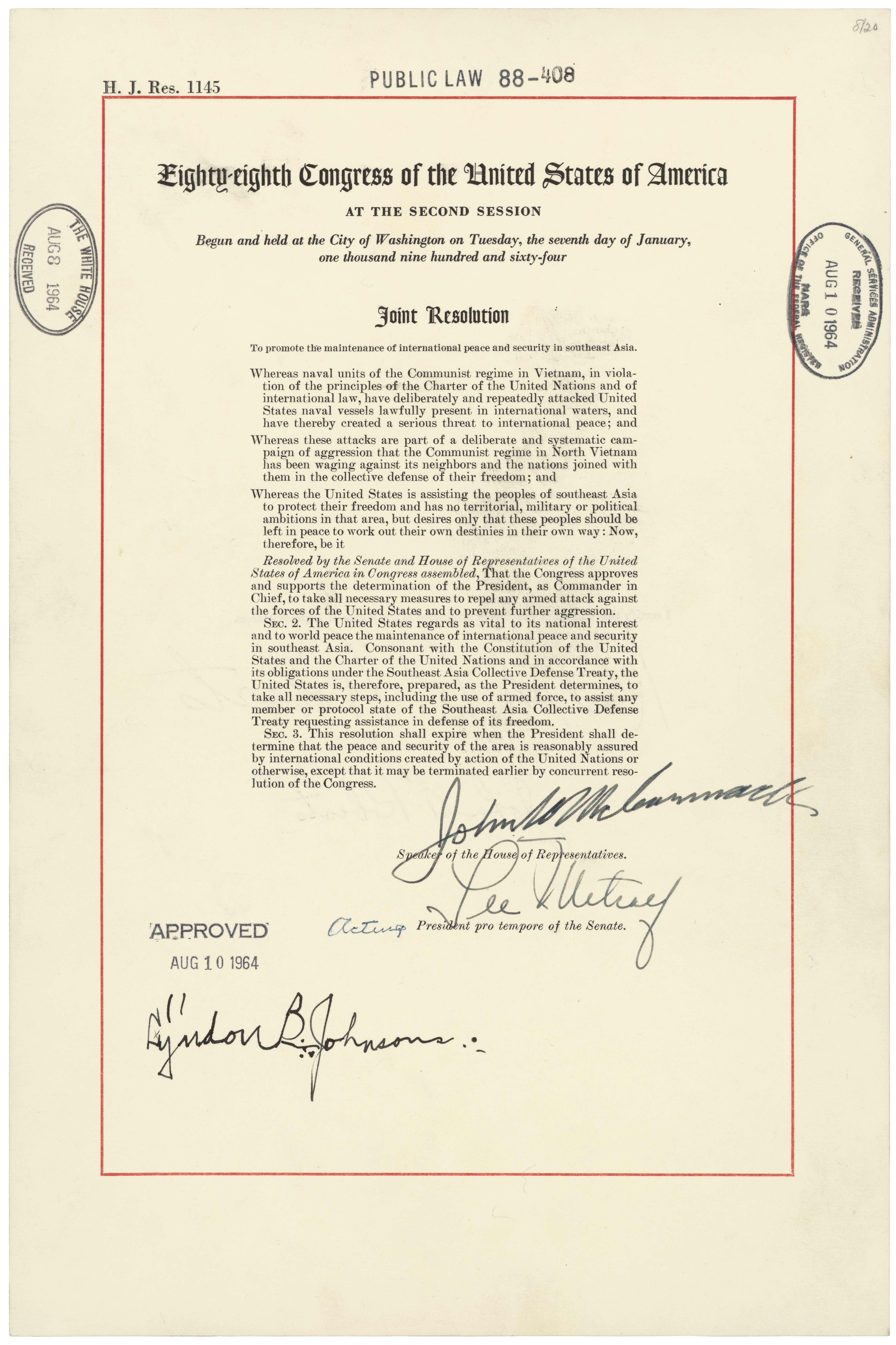
Document
UH-1D Medevac Helicopter in South Vietnam
10/16/1969
The original caption for this photograph reads: South Vietnam. A UH-1D Medevac helicopter takes off to pick up an injured member of the 101st Airborn Division, near the demilitarized zone.
This primary source comes from the Records of the Office of the Chief Signal Officer.
National Archives Identifier: 530627
Full Citation: UH-1D Medevac Helicopter in South Vietnam; 10/16/1969; Color Photographs of Signal Corps Activity, 1944 - 1981; Records of the Office of the Chief Signal Officer, ; National Archives at College Park, College Park, MD. [Online Version, https://docsteach.org/documents/document/medevac-helicopter, April 19, 2024]UH-1D Medevac Helicopter in South Vietnam
Page 1
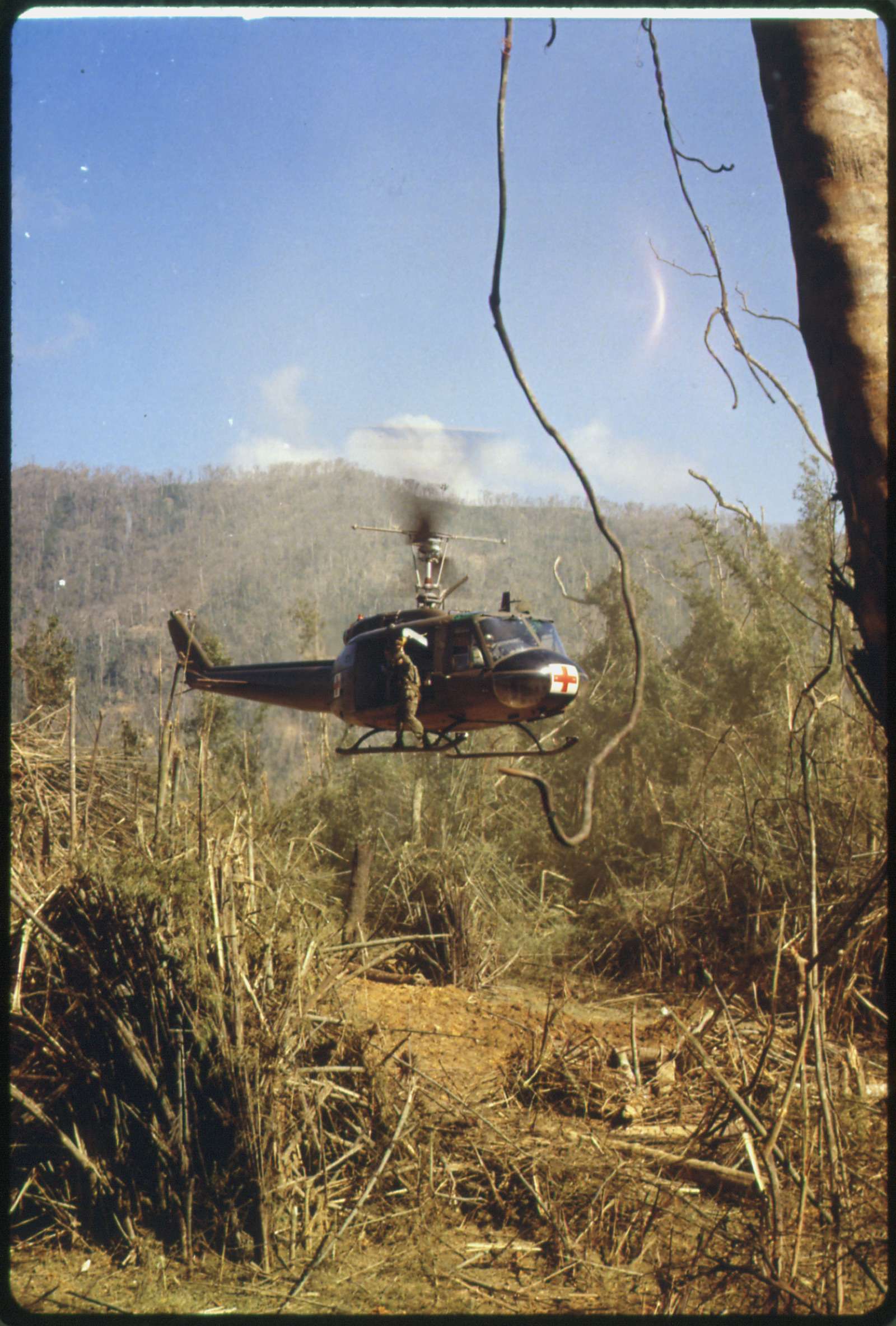
Document
Viet Cong Prisoner
1/23/1967
The original caption for this photograph reads: Thuong Duc, Vietnam....A Viet Cong prisoner awaits interrogation at the A-109 Special Forces Detachment in Thuong Duc, 25 km west of Da Nang.
This primary source comes from the Records of the Office of the Chief Signal Officer.
National Archives Identifier: 531447
Full Citation: Photograph 111-SC-636742; Viet Cong Prisoner; 1/23/1967; Photographs of American Military Activities, ca. 1918 - ca. 1981; Records of the Office of the Chief Signal Officer, ; National Archives at College Park, College Park, MD. [Online Version, https://docsteach.org/documents/document/viet-cong-prisoner, April 19, 2024]Viet Cong Prisoner
Page 1
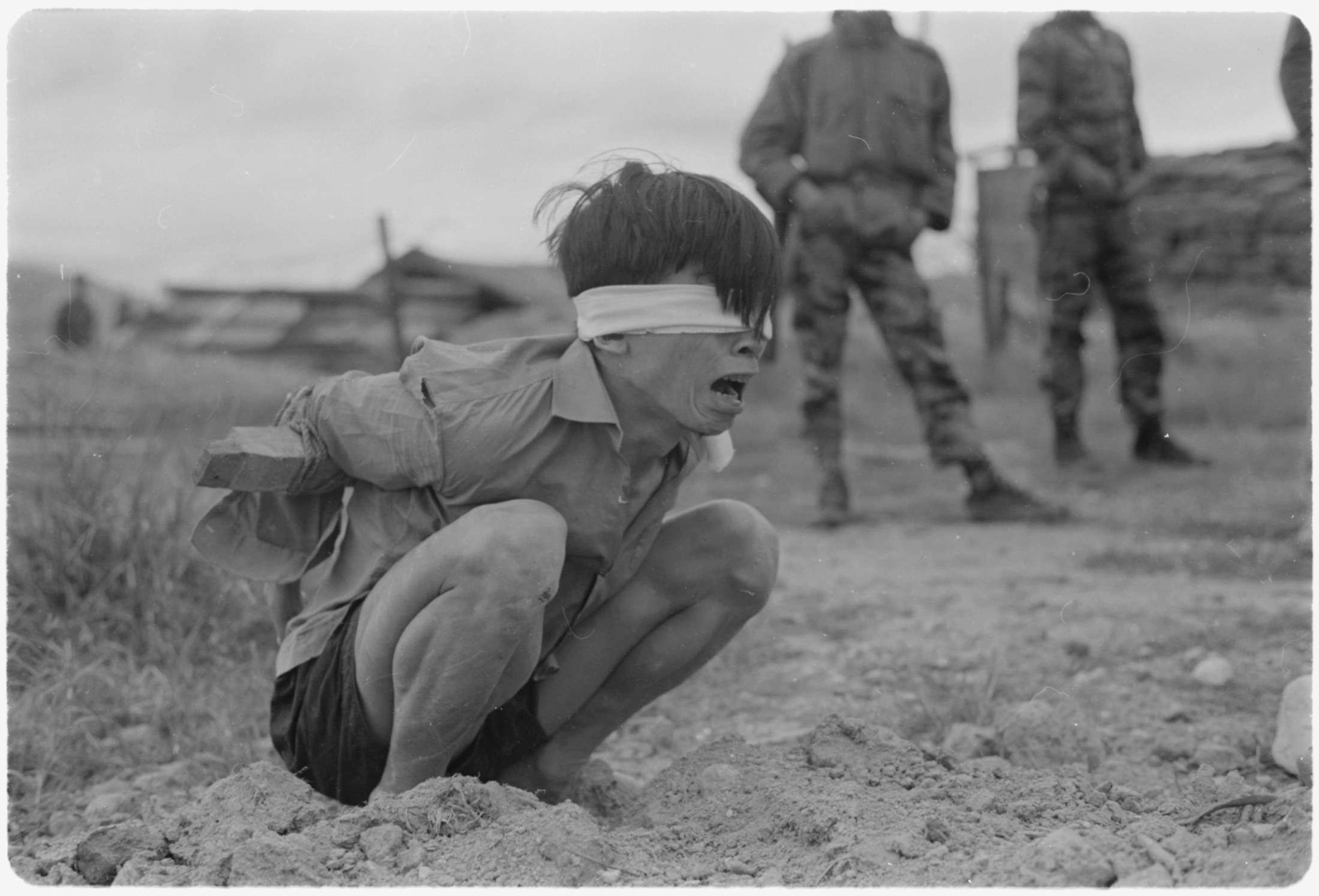
Document
Richard Nixon in Chu Lai, South Vietnam
9/5/1965
This photograph shows Richard Nixon shaking the hand of a Vietnamese soldier in Chu Lai, South Vietnam. Commander Nguyen Chang Thi stands behind Nixon.
The original caption reads: Chu Lai, South Viet Nam: Touring U.S. and Vietnamese troops in the field 9/5, former Vice President Richard Nixon shakes hand of a Vietnamese soldier in a foxhole. Behind Nixon is Vietnamese I Corps commander Nguyen Chanh Thi. Nixon voiced opposition here to a negotiated peace settlement at the present time, saying it would serve cause of war rather than peace.
The original caption reads: Chu Lai, South Viet Nam: Touring U.S. and Vietnamese troops in the field 9/5, former Vice President Richard Nixon shakes hand of a Vietnamese soldier in a foxhole. Behind Nixon is Vietnamese I Corps commander Nguyen Chanh Thi. Nixon voiced opposition here to a negotiated peace settlement at the present time, saying it would serve cause of war rather than peace.
This primary source comes from the Collection RN-FND: Richard Nixon Foundation Collection of Audiovisual Materials.
National Archives Identifier: 16916341
Full Citation: Photograph A10-024.45.10.1; Richard Nixon in Chu Lai, South Vietnam; 9/5/1965; Photographic Materials, ca. 1926 - ca. 1994; Collection RN-FND: Richard Nixon Foundation Collection of Audiovisual Materials, ; Richard Nixon Library, Yorba Linda, CA. [Online Version, https://docsteach.org/documents/document/nixon-chu-lai-south-vietnam, April 19, 2024]Richard Nixon in Chu Lai, South Vietnam
Page 1
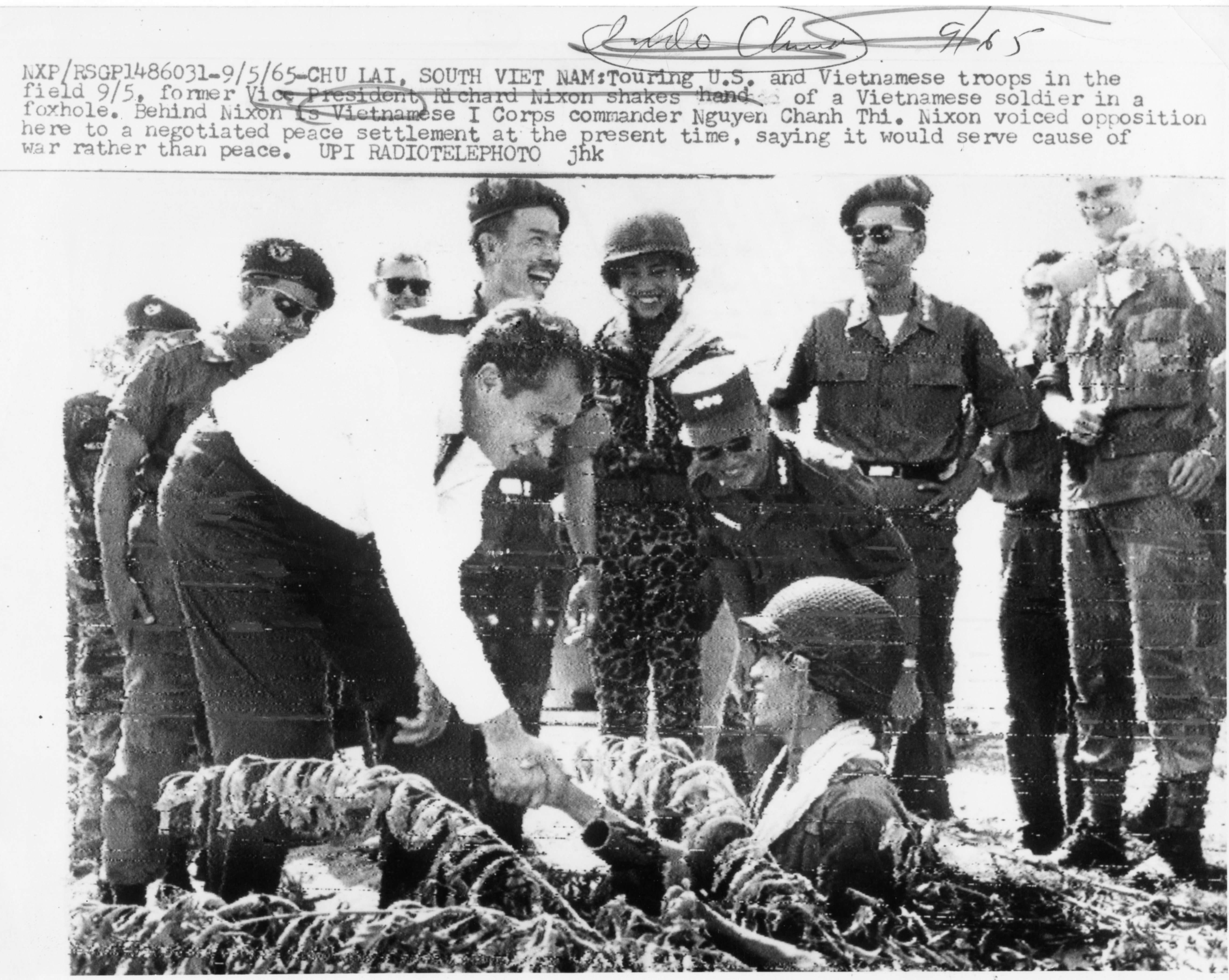
Document
Press Release Following the First Tonkin Gulf Incident
8/3/1964
This is a press release informing the public of actions taken following the August 2 attack on the USS Maddox in the Tonkin Gulf.
This primary source comes from the Collection LBJ-WHPRSO: White House Press Office Files.
National Archives Identifier: 2803400
Full Citation: Press Release Following the First Tonkin Gulf Incident; 8/3/1964; White House Press Releases, 11/22/1963 - 1/20/1969; Collection LBJ-WHPRSO: White House Press Office Files, ; Lyndon Baines Johnson Library, Austin, TX. [Online Version, https://docsteach.org/documents/document/first-tonkin-gulf-incident, April 19, 2024]Press Release Following the First Tonkin Gulf Incident
Page 1
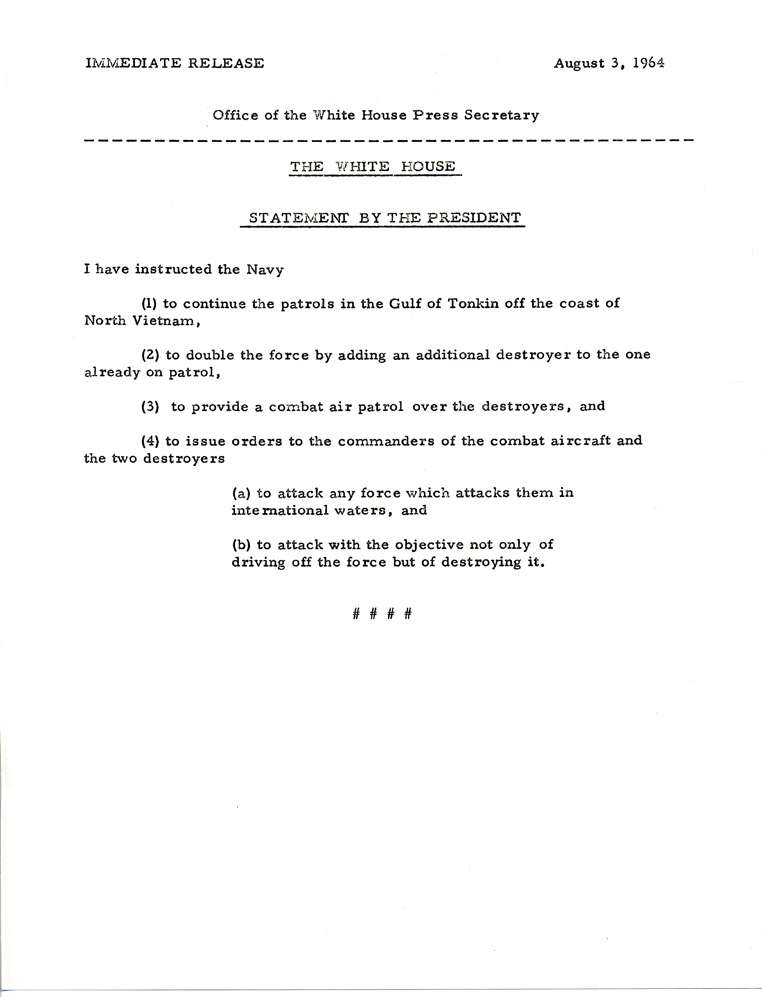
Document
Memorandum Notifying President Johnson of Attack on the USS Maddox
8/2/1964
This memorandum notified President Johnson about the attack on the USS Maddox in the Gulf of Tonkin.
This primary source comes from the Collection LBJ-NSF: National Security Files.
National Archives Identifier: 2803386
Full Citation: Memorandum Notifying President Johnson of Attack on the USS Maddox; 8/2/1964; Operation Pierce Arrow 8/64; Vietnam Country Files, 11/22/1963 - 1/20/1969; Collection LBJ-NSF: National Security Files, ; Lyndon Baines Johnson Library, Austin, TX. [Online Version, https://docsteach.org/documents/document/memorandum-attack-uss-maddox, April 19, 2024]Memorandum Notifying President Johnson of Attack on the USS Maddox
Page 1
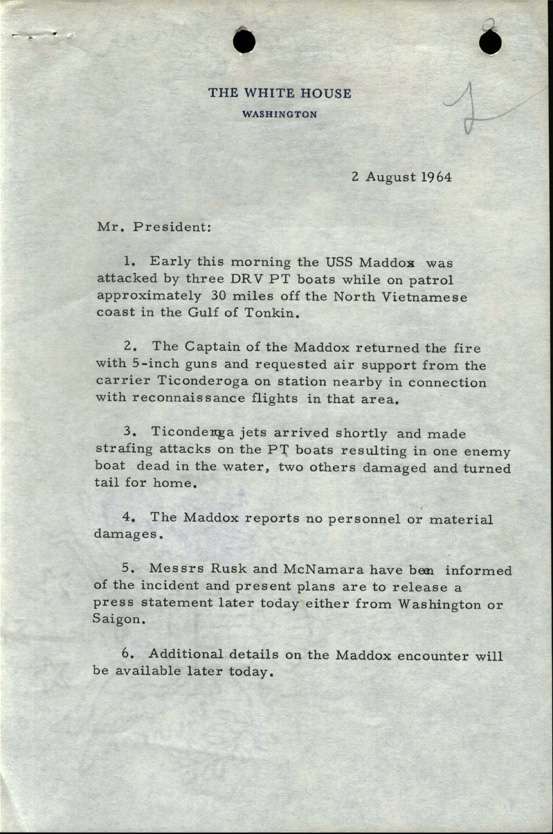
Document
Certification of the 26th Amendment
7/5/1971
The 26th Amendment to the Constitution, ratified on July 1, 1971, lowered the voting age to 18. This document shows the certification of the amendment by General Services Administrator Robert Kunzig on July 5th.
In a ceremony at the White House, President Richard M. Nixon also signed as a witness. President Nixon’s signature was unnecessary to ratify the 26th Amendment because the Constitution does not give the President a role in passing amendments. But Nixon ceremoniously signed it anyway, and he took the unprecedented step of inviting three 18-year-olds to also sign the new amendment.
In a ceremony at the White House, President Richard M. Nixon also signed as a witness. President Nixon’s signature was unnecessary to ratify the 26th Amendment because the Constitution does not give the President a role in passing amendments. But Nixon ceremoniously signed it anyway, and he took the unprecedented step of inviting three 18-year-olds to also sign the new amendment.
This primary source comes from the General Records of the United States Government.
National Archives Identifier: 1636091
Full Citation: Certification of the 26th Amendment; 7/5/1971; Ratified Amendments, 1795 - 1992; General Records of the United States Government, ; National Archives Building, Washington, DC. [Online Version, https://docsteach.org/documents/document/certification-26th-amendment, April 19, 2024]Certification of the 26th Amendment
Page 1

Certification of the 26th Amendment
Page 2

Document
A Viet Cong Soldier Crouches in a Bunker with an SKS Rifle
1968
This comes from a series of photographs taken by the Signal Corps to document and publicize United States Army activities and technological developments at home and abroad.
This primary source comes from the Records of the Office of the Chief Signal Officer.
National Archives Identifier: 530624
Full Citation: Photograph 111-C-CC53045; A Viet Cong Soldier Crouches in a Bunker with an SKS Rifle; 1968; Color Photographs of Signal Corps Activity, 1944 - 1981; Records of the Office of the Chief Signal Officer, ; National Archives at College Park, College Park, MD. [Online Version, https://docsteach.org/documents/document/viet-cong-soldier-bunker-sks-rifle, April 19, 2024]A Viet Cong Soldier Crouches in a Bunker with an SKS Rifle
Page 1
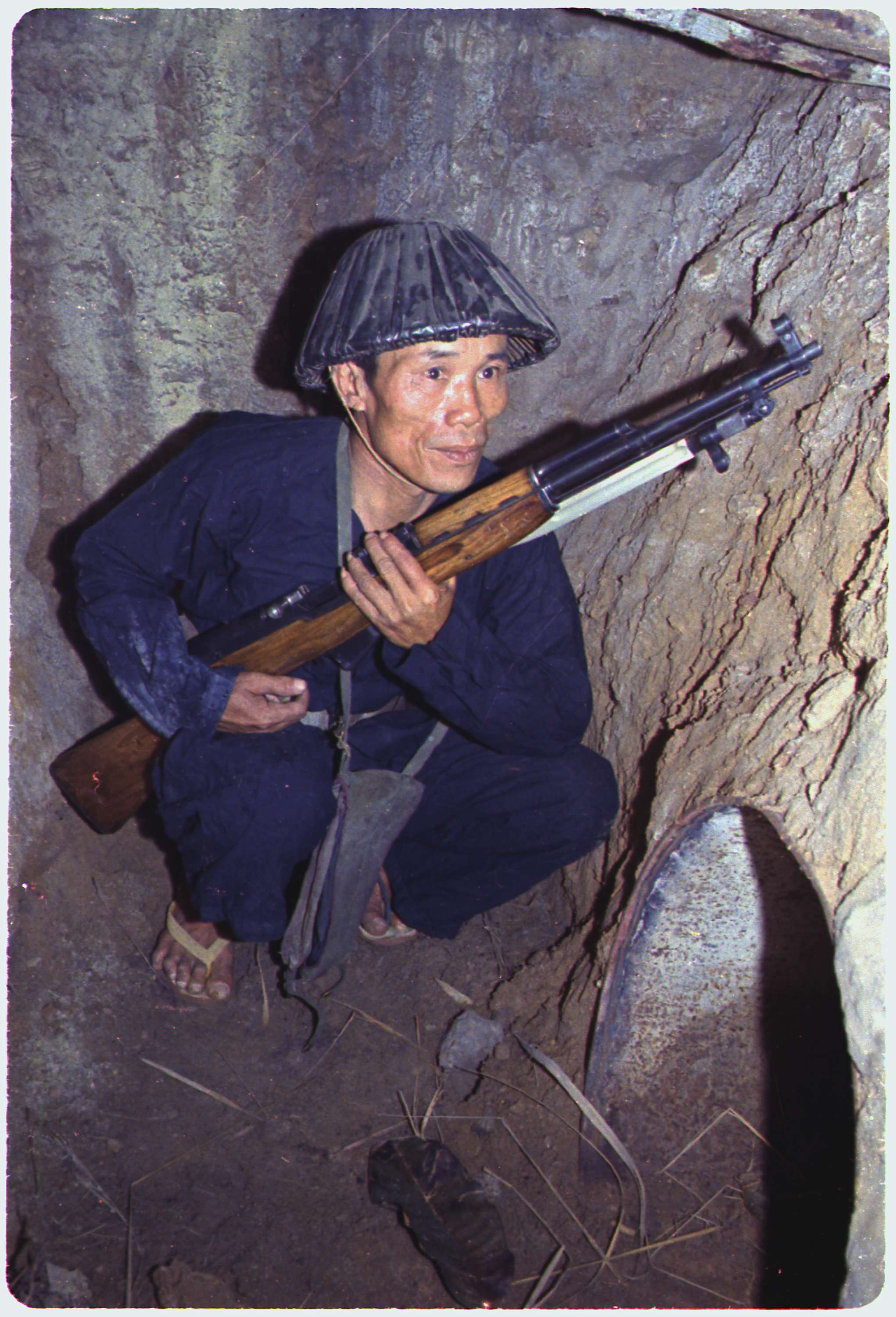
Document
President Richard Nixon Points to a Map of Cambodia during a Vietnam War Press Conference
4/30/1970
During the Vietnam War, in a coup strongly encouraged by the United States, a U.S.-friendly government came to power in Cambodia. The Vietnamese Communists had long used neutral Cambodia as a place to regroup and store weapons. The 12,000 miles of roads and paths built by Communists to connect North and South Vietnam through Cambodia and Laos was known as the Ho Chi Minh Trail. It was a critical supply route that the Communists credited with much of their success in the war.
President Nixon planned to send ground groups to Cambodia to attack Communist sanctuaries and central headquarters. One historical interpretation of Nixon’s strategy is that he hoped to destabilize the enemy in order to provide a “decent interval” in which South Vietnam could fend for itself while American troops pulled out.
Nixon televised his decision to initiate the Cambodian campaign. In this photograph he points out the locations of suspected Communist sanctuaries in Cambodia. The public was unaware that Nixon had been secretly bombing Cambodia since mid-March 1969—an escalation of a covert bombing campaign started by President Johnson in 1965.
The original caption for this photograph reads: President Richard Nixon Points to a Map of Cambodia during a Vietnam War Press Conference.
President Nixon planned to send ground groups to Cambodia to attack Communist sanctuaries and central headquarters. One historical interpretation of Nixon’s strategy is that he hoped to destabilize the enemy in order to provide a “decent interval” in which South Vietnam could fend for itself while American troops pulled out.
Nixon televised his decision to initiate the Cambodian campaign. In this photograph he points out the locations of suspected Communist sanctuaries in Cambodia. The public was unaware that Nixon had been secretly bombing Cambodia since mid-March 1969—an escalation of a covert bombing campaign started by President Johnson in 1965.
The original caption for this photograph reads: President Richard Nixon Points to a Map of Cambodia during a Vietnam War Press Conference.
This primary source comes from the Collection RN-WHPO: White House Photo Office Collection (Nixon Administration).
National Archives Identifier: 194674
Full Citation: Photograph NLRN-WHPO-3448-21A; President Richard Nixon Points to a Map of Cambodia during a Vietnam War Press Conference; 4/30/1970; Nixon White House Photographs, 1/20/1969 - 8/9/1974; Collection RN-WHPO: White House Photo Office Collection (Nixon Administration), ; Richard Nixon Library, Yorba Linda, California. [Online Version, https://docsteach.org/documents/document/nixon-press-conference-vietnam, April 19, 2024]President Richard Nixon Points to a Map of Cambodia during a Vietnam War Press Conference
Page 1

Document
Letter from Mrs. Keck to President Johnson Regarding her Son's Death
5/27/1967
Mrs. Charles Keck wrote this letter to President Johnson the day she and her husband buried her son, Corporal Russell Forrest Keck. She included a photograph of him.
Corporal Keck died in Vietnam on May 18, 1967. He was 20 years old. “Rusty” served as a Machine Gun Squad Leader with Company A, Battalion Landing Team 1/3, Ninth Marine Amphibious Brigade. He was killed in action during Operation Beau Charger in Quang Tin Province on May 18, 1967. Russell was posthumously awarded the Navy Cross for his "courageous actions, bold initiative, intrepid fighting spirit and sincere concern for others."
President Johnson sent a reply to the Kecks. The draft of his response letter, with its layers of revised and rejected phrases, reveals his struggle to respond.
Corporal Keck died in Vietnam on May 18, 1967. He was 20 years old. “Rusty” served as a Machine Gun Squad Leader with Company A, Battalion Landing Team 1/3, Ninth Marine Amphibious Brigade. He was killed in action during Operation Beau Charger in Quang Tin Province on May 18, 1967. Russell was posthumously awarded the Navy Cross for his "courageous actions, bold initiative, intrepid fighting spirit and sincere concern for others."
President Johnson sent a reply to the Kecks. The draft of his response letter, with its layers of revised and rejected phrases, reveals his struggle to respond.
This primary source comes from the Collection LBJ-WHCF: White House Central Files (Johnson Administration).
Full Citation: Letter from Mrs. Keck to President Johnson Regarding her Son's Death; 5/27/1967; Charles Keck Correspondence; White House Subject Files on National Security and Defense, 11/22/1963 - 1/20/1969; Collection LBJ-WHCF: White House Central Files (Johnson Administration), ; Lyndon Baines Johnson Library, Austin, TX. [Online Version, https://docsteach.org/documents/document/letter-keck-sons-death, April 19, 2024]Letter from Mrs. Keck to President Johnson Regarding her Son's Death
Page 1

Letter from Mrs. Keck to President Johnson Regarding her Son's Death
Page 2
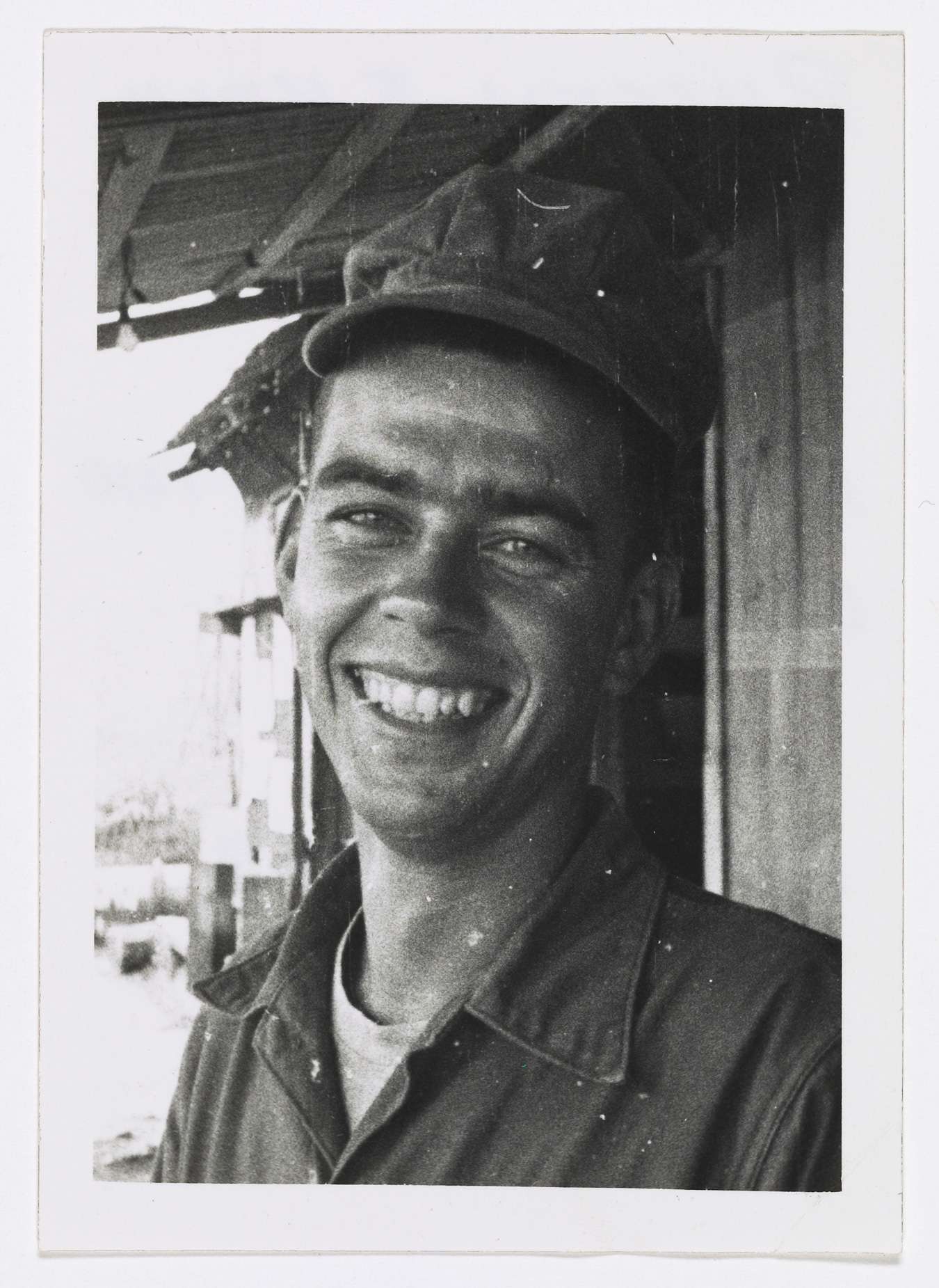
Letter from Mrs. Keck to President Johnson Regarding her Son's Death
Page 3

Document
Napalm bombs explode on Viet Cong structures south of Saigon in the Republic of Vietnam
1965
The original caption for this photograph reads: Napalm bombs explode on Viet Cong structures south of Saigon in the Republic of Vietnam.
This primary source comes from the Records of U.S. Air Force Commands, Activities, and Organizations.
National Archives Identifier: 542328
Full Citation: Napalm bombs explode on Viet Cong structures south of Saigon in the Republic of Vietnam; 1965; Photographs Relating to the Administration, Family, and Personal Life of Harry S. Truman, 1957-2004; Records of U.S. Air Force Commands, Activities, and Organizations, ; National Archives at College Park, College Park, MD. [Online Version, https://docsteach.org/documents/document/napalm-bombs-explode-structures, April 19, 2024]Napalm bombs explode on Viet Cong structures south of Saigon in the Republic of Vietnam
Page 1

Document
Statement by the President on Evacuation of American Personnel from South Viet Nam [Ford Speech or Statement]
4/29/1975
The White House released this statement by President Gerald Ford saying that the evacuation of all American personnel in South Viet Nam had been completed.
This primary source comes from the Collection GRF-0248: White House Press Releases (Ford Administration).
National Archives Identifier: 7338957
Full Citation: Statement by the President on Evacuation of American Personnel from South Viet Nam [Ford Speech or Statement]; 4/29/1975; Press Releases, April 29, 1975; Press Releases, 1974 - 1977; Collection GRF-0248: White House Press Releases (Ford Administration), ; Gerald R. Ford Library, Ann Arbor, MI. [Online Version, https://docsteach.org/documents/document/president-evacuation-south-vietnam, April 19, 2024]Statement by the President on Evacuation of American Personnel from South Viet Nam [Ford Speech or Statement]
Page 1
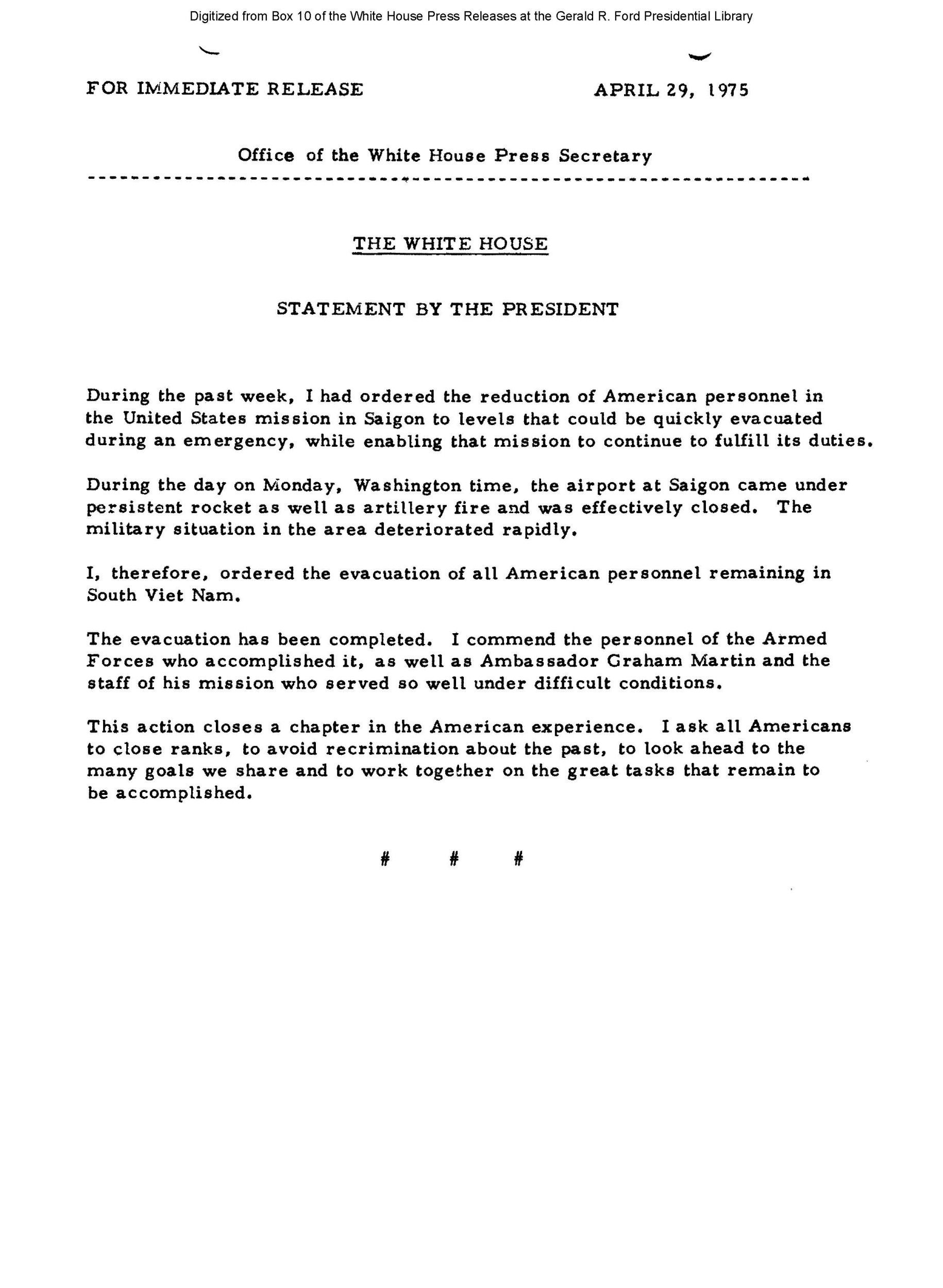
Document
President Johnson's Vietnam Address
8/4/1964
President Lyndon B. Johnson gave this "Midnight Address" from the White House after the second Gulf of Tonkin incident. He interrupted television broadcasts just before midnight to announce American ships had been attacked twice in international waters in the Gulf of Tonkin near North Vietnam. He gave no hint of some doubts he had expressed in a recorded conversation earlier that day.
The following morning, the Gulf of Tonkin Resolution was introduced in the Senate. In his address, the President assures the country, “we still seek no wider war.” By the end of the following year, 180,000 American troops were in Vietnam.
The following morning, the Gulf of Tonkin Resolution was introduced in the Senate. In his address, the President assures the country, “we still seek no wider war.” By the end of the following year, 180,000 American troops were in Vietnam.
Transcript
My fellow Americans:As President and Commander in Chief, it is my duty to the American people to report that renewed hostile actions against United States ships on the high seas in the Gulf of Tonkin have today required me to order the military forces of the United States to take action in reply.
The initial attack on the destroyer Maddox, on August 2, was repeated today by a number of hostile vessels attacking two U.S. destroyers with torpedoes. The destroyers and supporting aircraft acted at once on the orders I gave after the initial act of aggression. We believe at least two of the attacking boats were sunk. There were no U.S. losses.
The performance of commanders and crews in this engagement is in the highest tradition of the United States Navy. But repeated acts of violence against the Armed Forces of the United States must be met not only with alert defense, but with positive reply. That reply is being given as I speak to you tonight. Air action is now in execution against gunboats and certain supporting facilities in North Viet-Nam which have been used in these hostile operations.
In the larger sense this new act of aggression, aimed directly at our own forces, again brings home to all of us in the United States the importance of the struggle for peace and security in southeast Asia. Aggression by terror against the peaceful villagers of South Viet-Nam has now been joined by open aggression on the high seas against the United States of America.
The determination of all Americans to carry out our full commitment to the people and to the government of South Viet-Nam will be redoubled by this outrage. Yet our response, for the present, will be limited and fitting. We Americans know, although others appear to forget, the risks of spreading conflict. We still seek no wider war.
I have instructed the Secretary of State to make this position totally clear to friends and to adversaries and, indeed, to all. I have instructed Ambassador Stevenson to raise this matter immediately and urgently before the Security Council of the United Nations. Finally, I have today met with the leaders of both parties in the Congress of the United States and I have informed them that I shall immediately request the Congress to pass a resolution making it clear that our Government is united in its determination to take all necessary measures in support of freedom and in defense of peace in southeast Asia.
I have been given encouraging assurance by these leaders of both parties that such a resolution will be promptly introduced, freely and expeditiously debated, and passed with overwhelming support. And just a few minutes ago I was able to reach Senator Goldwater and I am glad to say that he has expressed his support of the statement that I am making to you tonight.
It is a solemn responsibility to have to order even limited military action by forces whose overall strength is as vast and as awesome as those of the United States of America, but it is my considered conviction, shared throughout your Government, that firmness in the right is indispensable today for peace; that firmness will always be measured. Its mission is peace.
Full Citation: Motion Picture 498; President Johnson's Vietnam Address; 8/4/1964; Lyndon Baines Johnson Library, Austin, TX. [Online Version, https://docsteach.org/documents/document/johnson-vietnam-address, April 19, 2024]
President Johnson's Vietnam Address
Page 1

Document
National Security Action Memorandum No. 115 Defoliant Operations in Vietnam
11/30/1961
This is a memorandum for Secretary of State, Secretary of Defense concerning defoliant operations in Vietnam.
This primary source comes from the Collection JFK-4: Papers of John F. Kennedy: Presidential Papers: National Security Files.
National Archives Identifier: 193508
Full Citation: National Security Action Memorandum No. 115 Defoliant Operations in Vietnam; 11/30/1961; National Security Files: Meetings and Memoranda: National Security Action Memoranda; Meeting Records and Memoranda, 1961 - 1963; Collection JFK-4: Papers of John F. Kennedy: Presidential Papers: National Security Files, ; John F. Kennedy Library, Boston, MA. [Online Version, https://docsteach.org/documents/document/memorandum-no-115-defoliant-operations, April 19, 2024]National Security Action Memorandum No. 115 Defoliant Operations in Vietnam
Page 1
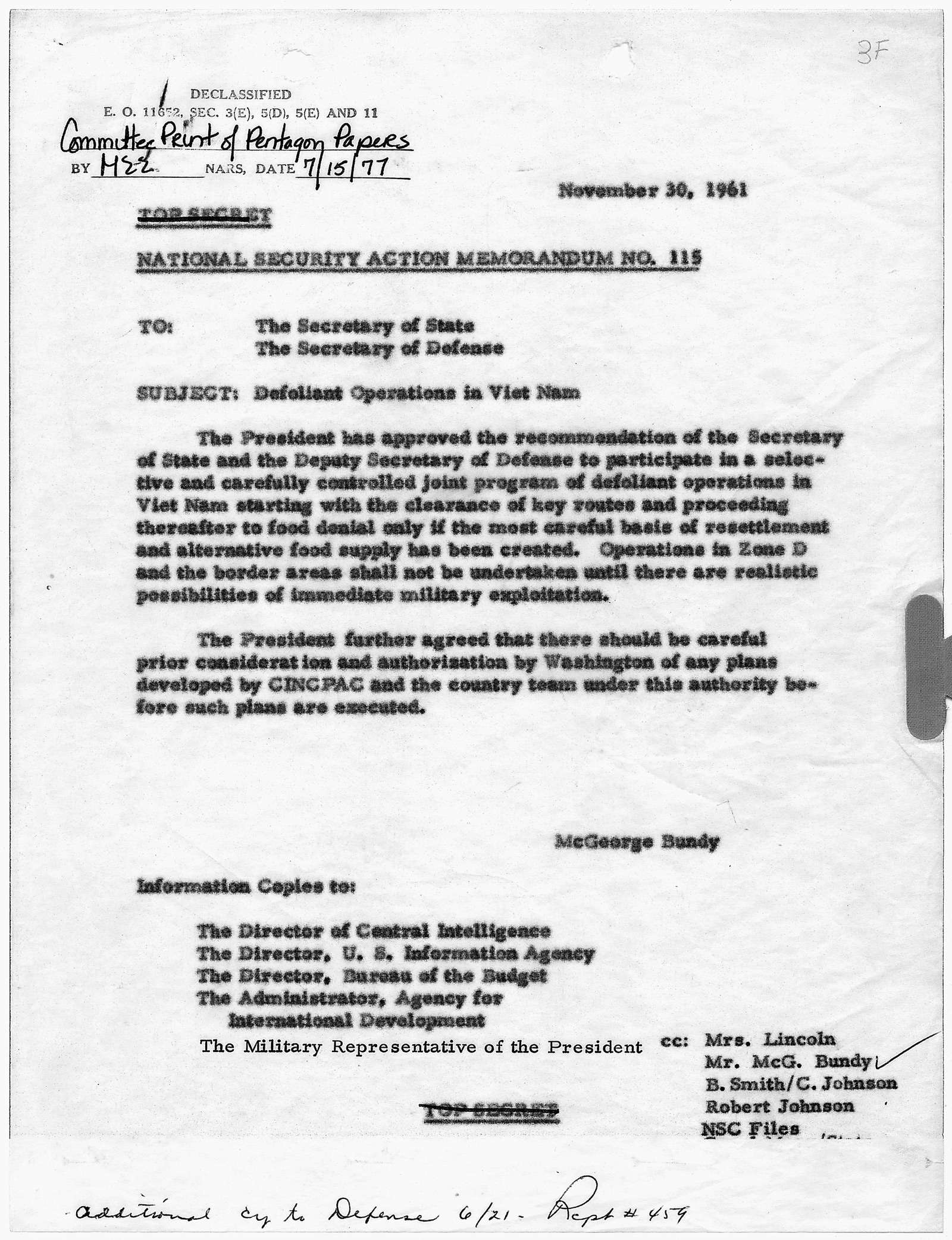
Document
Defendants' Exhibit 2 in John F. Tinker et. al. v. The Des Moines Independent Community School District et. al.
12/15/1965
This article from The Des Moines Register was entered as defendants' Exhibit 2 in John F. Tinker et. al. v. The Des Moines Independent Community School District et. al. It describes the decision of Des Moines, Iowa, school officials to ban students from wearing black armbands to school in support of a Vietnam War truce.
A group of junior high and high school students had decided to wear black arm bands from December 16th until New Year's Day to peacefully express their "grief over the deaths of soldiers and civilians in Vietnam."
On December 14, Des Moines School District principals met and enacted a rule that "any student wearing an arm band would be asked to remove the arm band, and if he refused he would be suspended until he returned without the arm band." The policy was announced to all students on December 15 as well as reported in this newspaper article. (A version of the policy typed up on December 23 was entered as Exhibit 3 in the court case.)
A group of junior high and high school students had decided to wear black arm bands from December 16th until New Year's Day to peacefully express their "grief over the deaths of soldiers and civilians in Vietnam."
On December 14, Des Moines School District principals met and enacted a rule that "any student wearing an arm band would be asked to remove the arm band, and if he refused he would be suspended until he returned without the arm band." The policy was announced to all students on December 15 as well as reported in this newspaper article. (A version of the policy typed up on December 23 was entered as Exhibit 3 in the court case.)
Students Mary Beth Tinker, John Tinker, Christopher Eckhardt, and two others were suspended after refusing to remove their black arm bands when they arrived at school on December 16th and 17th. About a dozen other students also wore arm bands. Upon their suspensions, the Tinkers and Eckhardt refused to return to school until after New Year's Day – the intended period for wearing the arm bands.
With assistance from the American Civil Liberties Union (ACLU), the Tinker and Eckhardt families filed a complaint against the school district for violation of the right to free speech under the First Amendment, and further that First Amendment rights are protected from state infringement (such as a public school board) under the due process clause in the Fourteenth Amendment.
The Tinkers and Eckhardts testified that their purpose for wearing the arm bands was to mourn those who died in the Vietnam War and to support Senator Robert Kennedy's proposal that the truce proposed for Christmas Day 1965 be indefinitely extended.
The U.S. District Court dismissed the case, agreeing with the school district's actions, based on their claim that the arm bands would have caused a disruption at the school. After the U.S. Court of Appeals for the 8th Circuit split evenly over the decision, thus upholding the District Court decision by default, the Tinkers and Eckhardts appealed their case to the Supreme Court.
In the landmark 1969 Tinker v. Des Moines decision, the Supreme Court ruled in favor of the plaintiffs, the Tinkers and Eckhardts. In the opinion, written by Supreme Court Justice Abe Fortas, the Court stated "[The wearing of arm bands] was closely akin to 'pure speech' which, we have repeatedly held, is entitled to comprehensive protection under the First Amendment." Further, "It can hardly be argued that either students or teachers shed their constitutional rights to freedom of speech or expression at the schoolhouse gate," Justice Fortas wrote for the majority.
With assistance from the American Civil Liberties Union (ACLU), the Tinker and Eckhardt families filed a complaint against the school district for violation of the right to free speech under the First Amendment, and further that First Amendment rights are protected from state infringement (such as a public school board) under the due process clause in the Fourteenth Amendment.
The Tinkers and Eckhardts testified that their purpose for wearing the arm bands was to mourn those who died in the Vietnam War and to support Senator Robert Kennedy's proposal that the truce proposed for Christmas Day 1965 be indefinitely extended.
The U.S. District Court dismissed the case, agreeing with the school district's actions, based on their claim that the arm bands would have caused a disruption at the school. After the U.S. Court of Appeals for the 8th Circuit split evenly over the decision, thus upholding the District Court decision by default, the Tinkers and Eckhardts appealed their case to the Supreme Court.
In the landmark 1969 Tinker v. Des Moines decision, the Supreme Court ruled in favor of the plaintiffs, the Tinkers and Eckhardts. In the opinion, written by Supreme Court Justice Abe Fortas, the Court stated "[The wearing of arm bands] was closely akin to 'pure speech' which, we have repeatedly held, is entitled to comprehensive protection under the First Amendment." Further, "It can hardly be argued that either students or teachers shed their constitutional rights to freedom of speech or expression at the schoolhouse gate," Justice Fortas wrote for the majority.
This primary source comes from the Records of District Courts of the United States.
National Archives Identifier: 7788707
Full Citation: Defendants' Exhibit 2 in John F. Tinker et. al. v. The Des Moines Independent Community School District et. al.; 12/15/1965; Civil Case Number 7-1810-C1; John F. Tinker et. al. v. The Des Moines Independent Community School District et. al.; Civil Case Files, 1938 - 1997; Records of District Courts of the United States, ; National Archives at Kansas City, Kansas City, MO. [Online Version, https://docsteach.org/documents/document/schools-ban-armbands, April 19, 2024]Defendants' Exhibit 2 in John F. Tinker et. al. v. The Des Moines Independent Community School District et. al.
Page 1
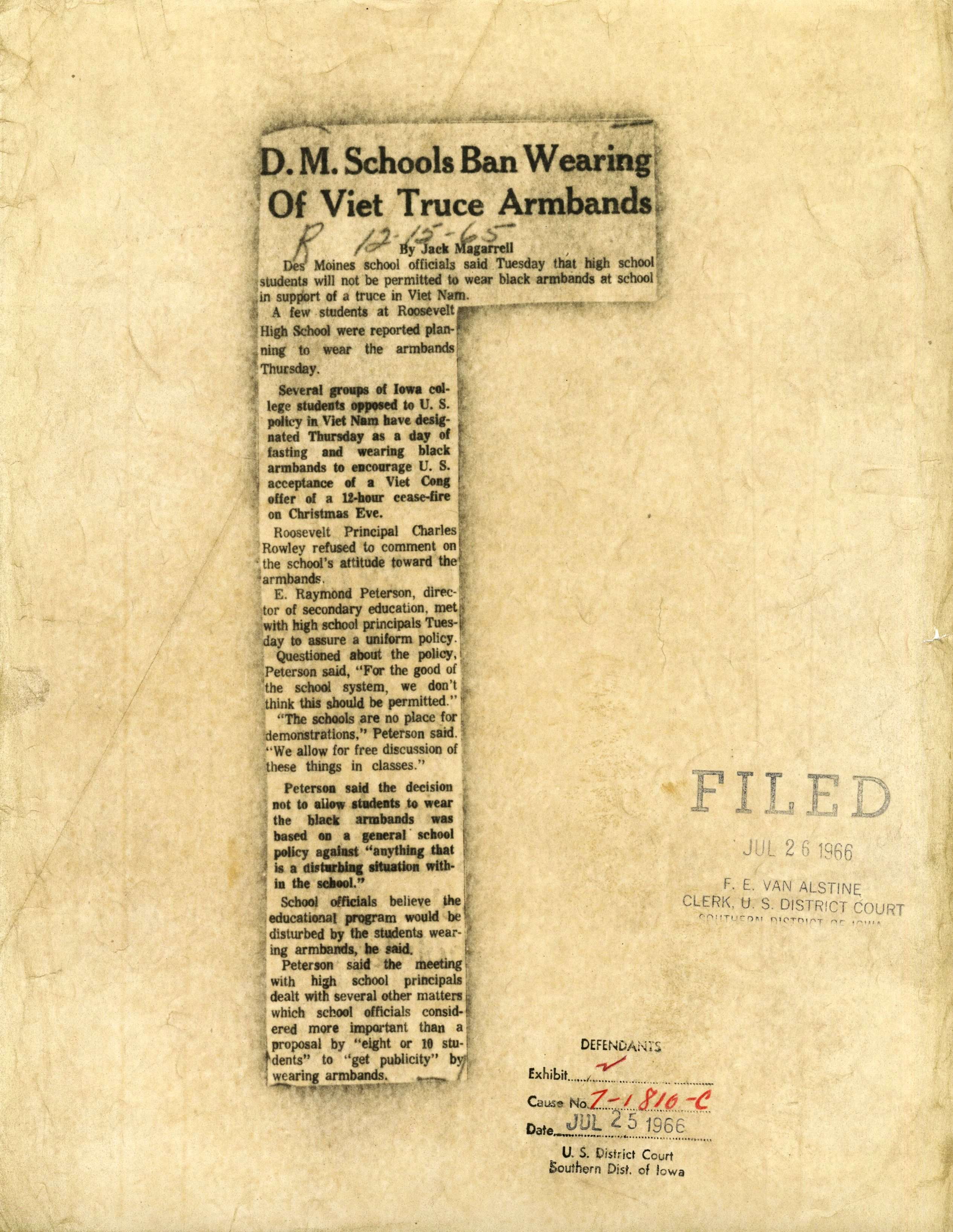
Document
Rolling Thunder 53 Strike Map
1/1967
President Lyndon B. Johnson was faced with a deteriorating situation in Vietnam after winning the 1964 Presidential election. His advisers predicted "disastrous defeat." Johnson planned a course of gradual escalation.
In early 1965, after southern Communist forces attacked a U.S. Army airfield in South Vietnam, the administration had a pretext to launch Operation Rolling Thunder, a sustained bombing campaign against the north. This map shows “red zones” where bombing was prohibited by the White House. During Rolling Thunder, U.S. bombers dropped 643,000 tons of bombs between 1965 and 1968, killing approximately 52,000 Vietnamese civilians.
An air campaign necessitated an air base, and an air base needed protection, so the first American boots hit the ground soon after the bombing began. Hundreds of thousands of U.S. combat troops would follow. America was at war.
In early 1965, after southern Communist forces attacked a U.S. Army airfield in South Vietnam, the administration had a pretext to launch Operation Rolling Thunder, a sustained bombing campaign against the north. This map shows “red zones” where bombing was prohibited by the White House. During Rolling Thunder, U.S. bombers dropped 643,000 tons of bombs between 1965 and 1968, killing approximately 52,000 Vietnamese civilians.
An air campaign necessitated an air base, and an air base needed protection, so the first American boots hit the ground soon after the bombing began. Hundreds of thousands of U.S. combat troops would follow. America was at war.
Full Citation: Rolling Thunder 53 Strike Map; 1/1967; Lyndon Baines Johnson Library, Austin, TX. [Online Version, https://docsteach.org/documents/document/rolling-thunder-53-strike-map, April 19, 2024]
Rolling Thunder 53 Strike Map
Page 1
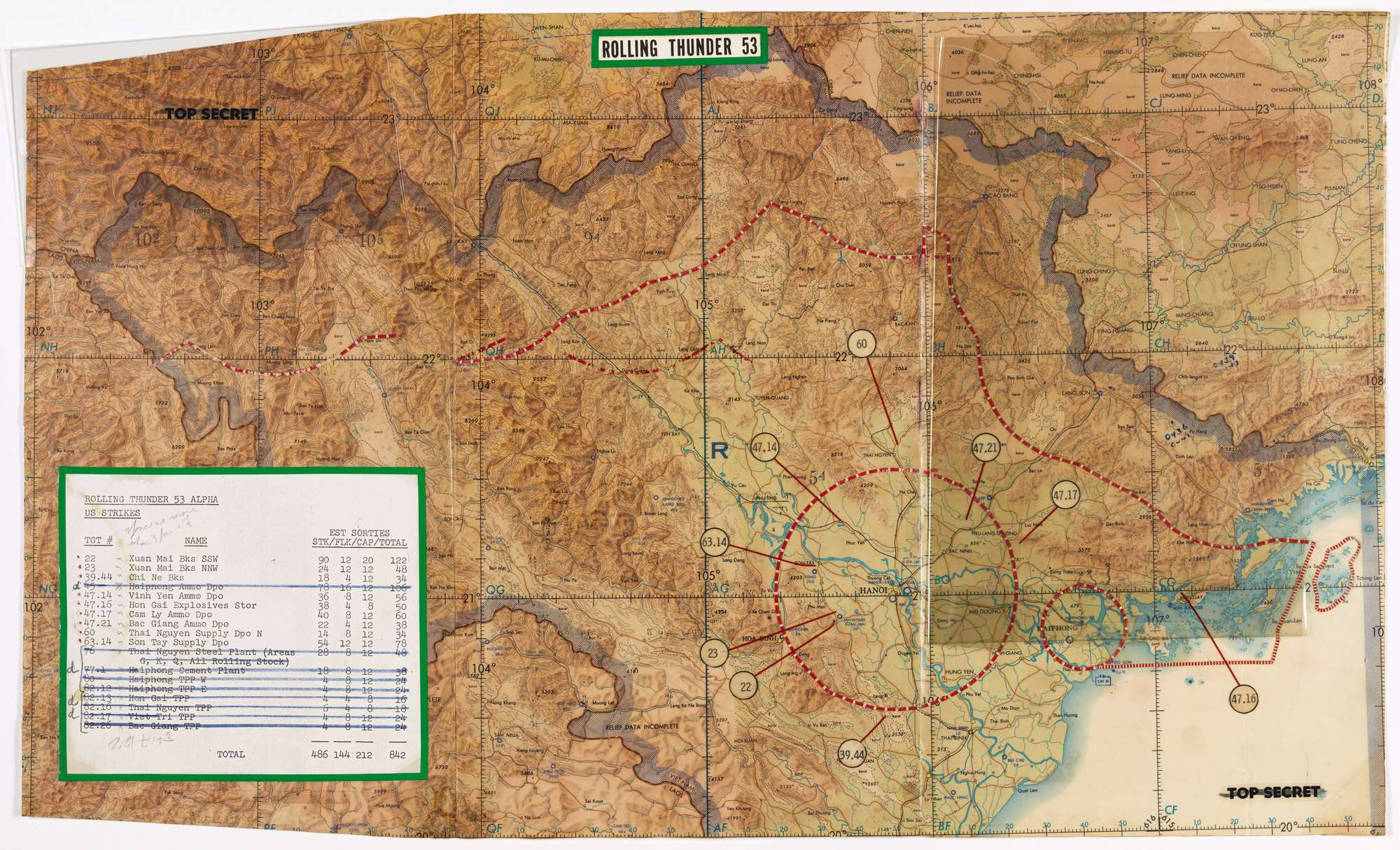
Document
Operation Shelby—PFC Manuel Garcia (El Centro, Calif.) Rifleman, Co. E, 3rd Bn, 7th Inf, 199th Light Inf. Bde., Cleans His M–16 Rifle
8/25/1967-8/26/1967
Original caption of this photograph reads: Operation Shelby—PFC Manuel Garcia (El Centro, Calif.) rifleman, Co. E, 3rd Bn, 7th Inf, 199th Light Inf. Bde., cleans his M–16 rifle prior to going out on a daily patrol at the new forward base camp located at the Kinh Kang and Kanh Nang Canals, 24 km west of Saigon.
This primary source comes from the Records of the Office of the Chief Signal Officer.
Full Citation: Photograph 111-CC-43628; Operation Shelby—PFC Manuel Garcia (El Centro, Calif.) Rifleman, Co. E, 3rd Bn, 7th Inf, 199th Light Inf. Bde., Cleans His M–16 Rifle; 8/25/1967-8/26/1967; Color Photographs of Signal Corps Activity, 1944 - 1981; Records of the Office of the Chief Signal Officer, ; National Archives at College Park, College Park, MD. [Online Version, https://docsteach.org/documents/document/operation-shelby-rifle, April 19, 2024]Operation Shelby—PFC Manuel Garcia (El Centro, Calif.) Rifleman, Co. E, 3rd Bn, 7th Inf, 199th Light Inf. Bde., Cleans His M–16 Rifle
Page 1
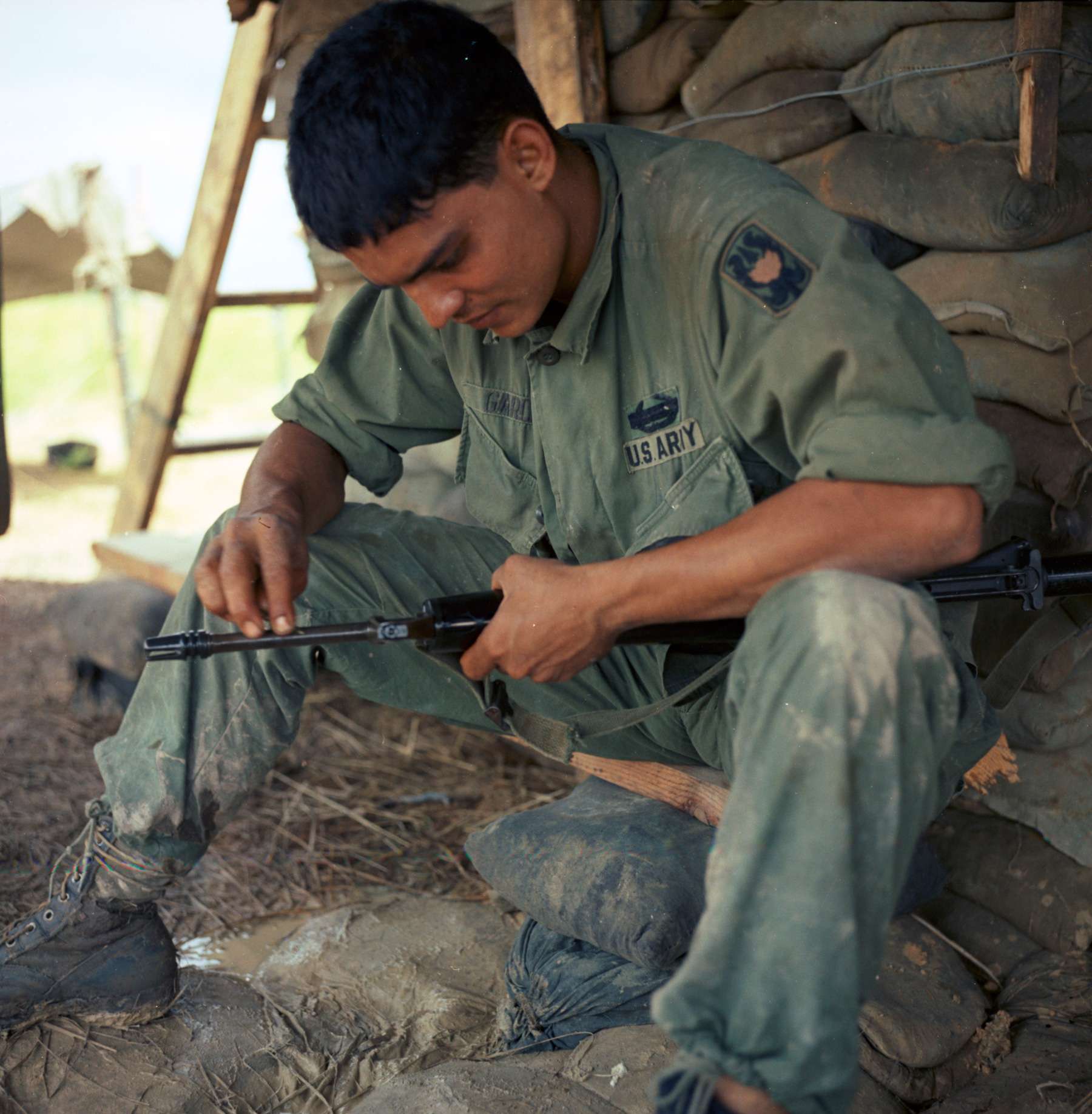
Document
Draft Page Three of the Last Section of the March 31, 1968 Speech by Lyndon Johnson
3/31/1968
The first drafts of this March speech by President Lyndon B. Johnson emphasized winning the war in Vietnam. An alternate version emphasized ending the war — Johnson chose that one. He called for a halt to bombing, greater reliance on the South Vietnamese, and a modest troop increase. In April, North Vietnam agreed to open peace talks.
Shown on this page, Johnson shocked even his closest advisers when he announced his decision not to run for a second term as President: “I shall not seek, and I will not accept, the nomination of my party for another term as your President.”
This draft includes corrections in the President's handwriting.
Shown on this page, Johnson shocked even his closest advisers when he announced his decision not to run for a second term as President: “I shall not seek, and I will not accept, the nomination of my party for another term as your President.”
This draft includes corrections in the President's handwriting.
This primary source comes from the Collection LBJ-STMNT: Statements Files.
National Archives Identifier: 2803405
Full Citation: Draft Page Three of the Last Section of the March 31, 1968 Speech by Lyndon Johnson; 3/31/1968; 3/31/68 Original Drafts "Accordingly I Shall Not Seek - and Would Not Accept the Nomination of my Party for Another Term"; Statements Files, 9/23/1927 - 12/26/1972; Collection LBJ-STMNT: Statements Files, ; Lyndon Baines Johnson Library, Austin, TX. [Online Version, https://docsteach.org/documents/document/withdrawal-johnson, April 19, 2024]Draft Page Three of the Last Section of the March 31, 1968 Speech by Lyndon Johnson
Page 1

Document
Memo from Walt W. Rostow to President Johnson
1/30/1968
Special Assistant for National Security Affairs Walt Rostow notified President Lyndon B. Johnson of the breach of the U.S. Embassy in Saigon. Nineteen Vietcong invaders gained access by blowing a hole in its wall. The resulting six-hour battle ended when all of the intruders were either killed or wounded. One Marine and four American military police were killed defending the embassy.
This was the beginning of the first phase of the Tet Offensive assault, when 70,000 Communist troops struck more than 100 towns and cities with swift and stunning ferocity. Most of the fighting was over in a few days, but a second wave came in late April and a third in August.
Although the North Vietnamese suffered devastating casualties and their attempt to spark a general uprising failed, many Americans concluded the U.S. and its allies had suffered a massive defeat. When a Defense Department report regarding the need for 205,000 more American troops was leaked to the New York Times, Americans concluded the war was stalemated and the Johnson administration had lied to them.
This was the beginning of the first phase of the Tet Offensive assault, when 70,000 Communist troops struck more than 100 towns and cities with swift and stunning ferocity. Most of the fighting was over in a few days, but a second wave came in late April and a third in August.
Although the North Vietnamese suffered devastating casualties and their attempt to spark a general uprising failed, many Americans concluded the U.S. and its allies had suffered a massive defeat. When a Defense Department report regarding the need for 205,000 more American troops was leaked to the New York Times, Americans concluded the war was stalemated and the Johnson administration had lied to them.
This primary source comes from the Collection LBJ-NSF: National Security Files.
Full Citation: Memo from Walt W. Rostow to President Johnson; 1/30/1968; Vietnam Country Files, 11/22/1963 - 1/20/1969; Collection LBJ-NSF: National Security Files, ; Lyndon Baines Johnson Library, Austin, TX. [Online Version, https://docsteach.org/documents/document/memo-walt-rostow-president-johnson, April 19, 2024]Memo from Walt W. Rostow to President Johnson
Page 1
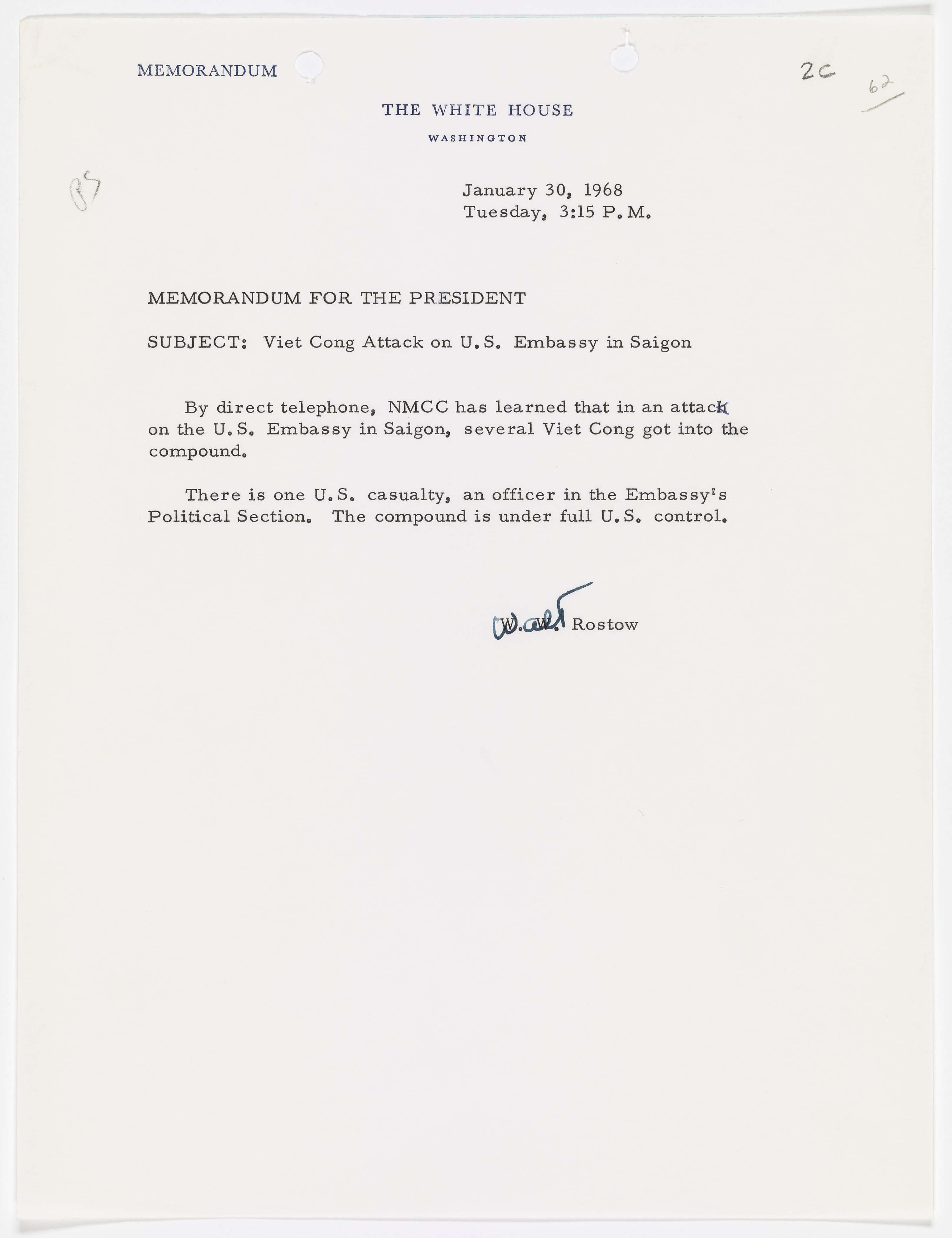
Document
December 1966: Footage of President Johnson, Lady Bird, and Daughter Lynda Visiting with Combat Soldiers Wounded in Vietnam and on Their Way to Military Hospitals in the San Antonio, Texas Area.
12/1966
This is a clip from the film "The President: December 1966," a narrative account of President Lyndon B. Johnson's activities for the month, created by the Naval Photographic Center. It shows President Johnson, Lady Bird Johnson, and their daughter Lynda at Kelly Air Force Base visiting with combat soldiers wounded in Vietnam on their way to military hospitals in the San Antonio, Texas area. It also includes footage of anti-war demonstrators.
This primary source comes from the Collection LBJ-WHNPC: White House Naval Photographic Center Films.
National Archives Identifier: 24460163
Full Citation: Motion Picture MP880; December 1966: Footage of President Johnson, Lady Bird, and Daughter Lynda Visiting with Combat Soldiers Wounded in Vietnam and on Their Way to Military Hospitals in the San Antonio, Texas Area.; 12/1966; Materials Relating to "The President: December 1966" Project , 12/1/1966 - 12/31/1966; Collection LBJ-WHNPC: White House Naval Photographic Center Films, ; Lyndon Baines Johnson Library, Austin, TX. [Online Version, https://docsteach.org/documents/document/first-family-visiting-soldiers, April 19, 2024]December 1966: Footage of President Johnson, Lady Bird, and Daughter Lynda Visiting with Combat Soldiers Wounded in Vietnam and on Their Way to Military Hospitals in the San Antonio, Texas Area.
Page 1
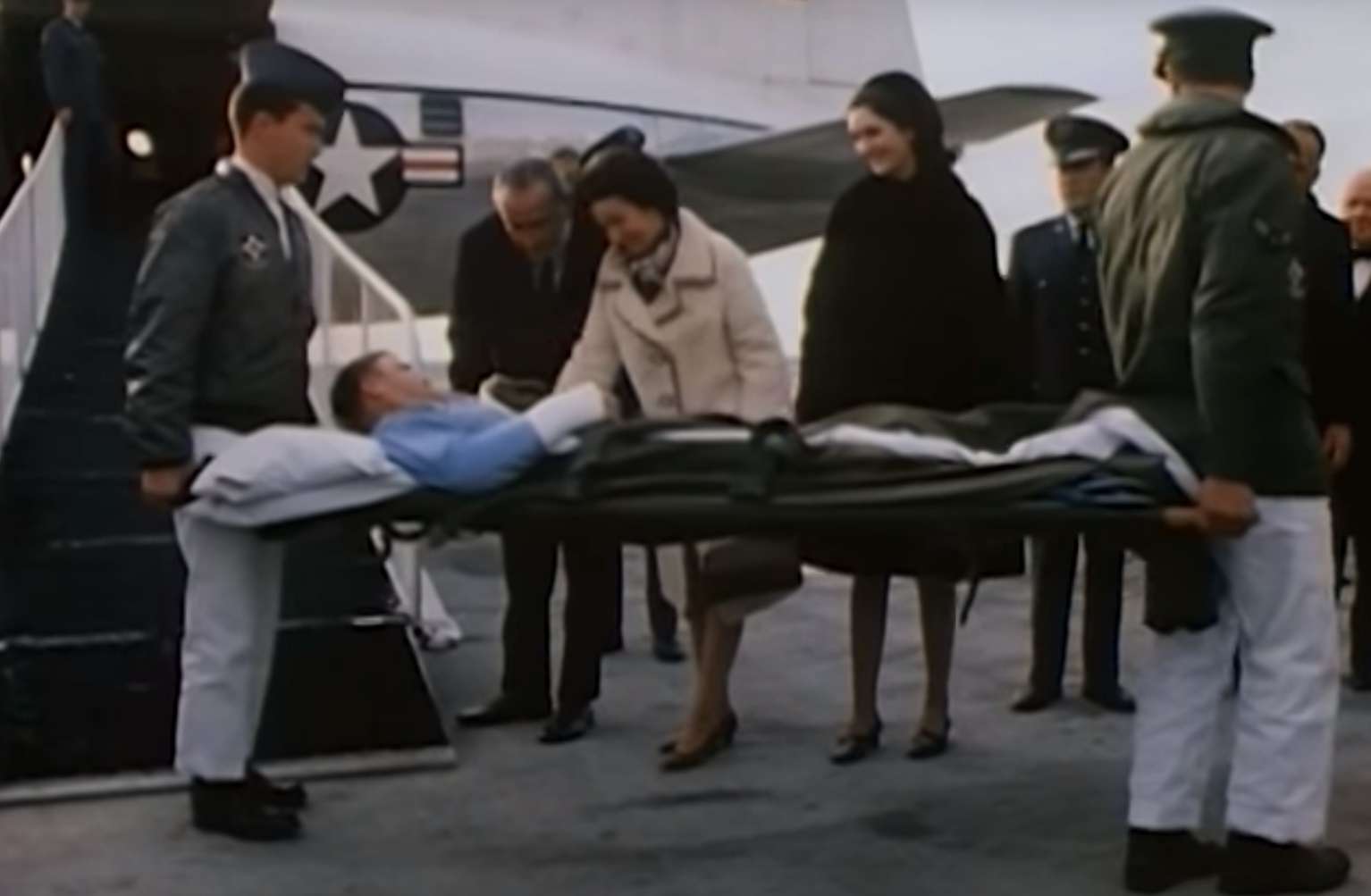
Document
Vietnam. Defoliation Mission.
7/26/1969
The original caption for this photograph reads: Vietnam. Defoliation Mission. A UH-1D helicopter from the 336th Aviation Company sprays a defoliation agent on a dense jungle area in the Mekong delta.
This primary source comes from the Records of the Office of the Chief Signal Officer.
National Archives Identifier: 530626
Full Citation: Photograph 111-C-CC59950; Vietnam. Defoliation Mission.; 7/26/1969; Color Photographs of Signal Corps Activity, 1944 - 1981; Records of the Office of the Chief Signal Officer, ; National Archives at College Park, College Park, MD. [Online Version, https://docsteach.org/documents/document/aviation-company-sprays-defoliation-jungle, April 19, 2024]Vietnam. Defoliation Mission.
Page 1
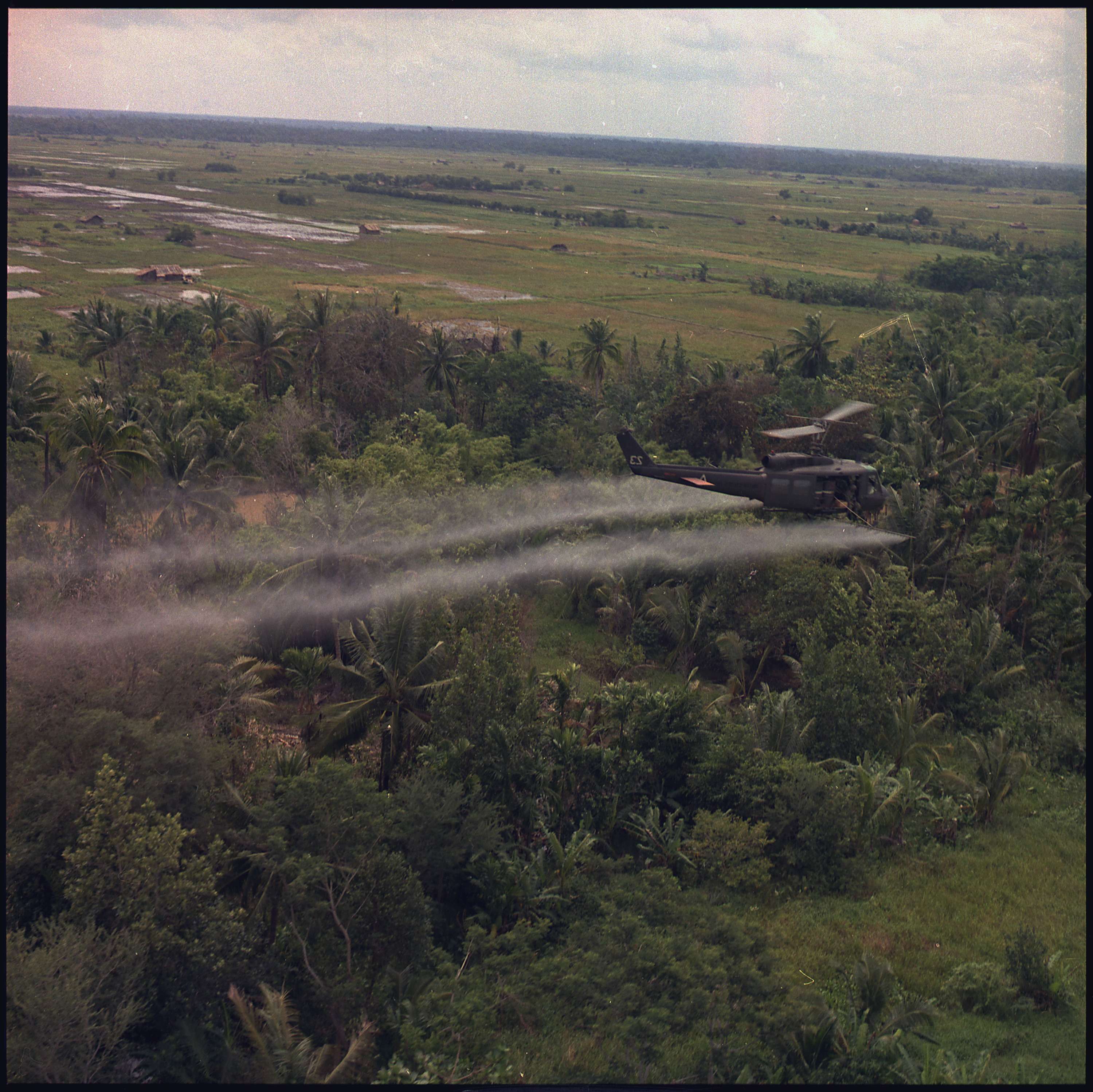
Document
Photograph contact sheet, 2/7/1968, 1968-02-07-C8489
2/7/1968
In the wake of the Tet Offensive, the Johnson administration began to question its strategy in Vietnam. On January 31, 1968, the South Vietnamese had been looking forward to Tet, a celebration of the lunar new year. They were caught off guard when 70,000 Communist troops struck more than 100 towns and cities with swift and stunning ferocity.
Most of the fighting was over in a few days, but a second wave came in late April and a third in August. Although the enemy suffered devastating casualties and their attempt to spark a general uprising completely failed, many Americans concluded the U.S. and its allies had suffered a massive defeat. When a Defense Department report regarding the need for 205,000 more American troops was leaked to the New York Times, Americans concluded the war was stalemated and the Johnson administration had lied to them.
This photograph comes from a contact sheet from the White House Photo Office (WHPO) during the Johnson administration.
Most of the fighting was over in a few days, but a second wave came in late April and a third in August. Although the enemy suffered devastating casualties and their attempt to spark a general uprising completely failed, many Americans concluded the U.S. and its allies had suffered a massive defeat. When a Defense Department report regarding the need for 205,000 more American troops was leaked to the New York Times, Americans concluded the war was stalemated and the Johnson administration had lied to them.
This photograph comes from a contact sheet from the White House Photo Office (WHPO) during the Johnson administration.
This primary source comes from the Collection LBJ-WHPO: White House Photo Office Collection.
Full Citation: Photograph C8489-18; Photograph contact sheet, 2/7/1968, 1968-02-07-C8489; 2/7/1968; Johnson White House Photographs, 11/22/1963 - 1/20/1969; Collection LBJ-WHPO: White House Photo Office Collection, ; Lyndon Baines Johnson Library, Austin, TX. [Online Version, https://docsteach.org/documents/document/johnson-mcnamara-meeting, April 19, 2024]Photograph contact sheet, 2/7/1968, 1968-02-07-C8489
Page 1
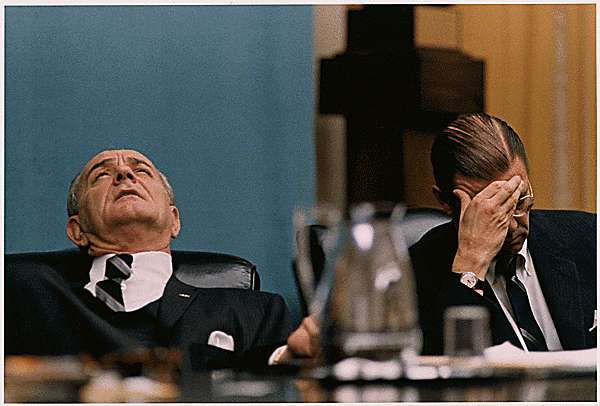
Photograph contact sheet, 2/7/1968, 1968-02-07-C8489
Page 2

Document
314 - ARVN (Army of the Republic of Vietnam) - 1969
1969
The original caption for this photograph reads: A Regional Forces Soldier keeps a vigil during a rest stop enroute [sic] to the suspected Viet Cong Base Camp.
This primary source comes from the Records of the U.S. Marine Corps.
National Archives Identifier: 26401634
Full Citation: Photograph 127-GVB-314-A193587; 314 - ARVN (Army of the Republic of Vietnam) - 1969; 1969; Divider/Subject - 314 - ARVN - 1969, 1962 - 1975; Black and White Photographs of Marine Corps Activities in Vietnam, 1962 - 1975; Records of the U.S. Marine Corps, ; National Archives at College Park, College Park, MD. [Online Version, https://docsteach.org/documents/document/forces-enroute-viet-cong-base-camp, April 19, 2024]314 - ARVN (Army of the Republic of Vietnam) - 1969
Page 1
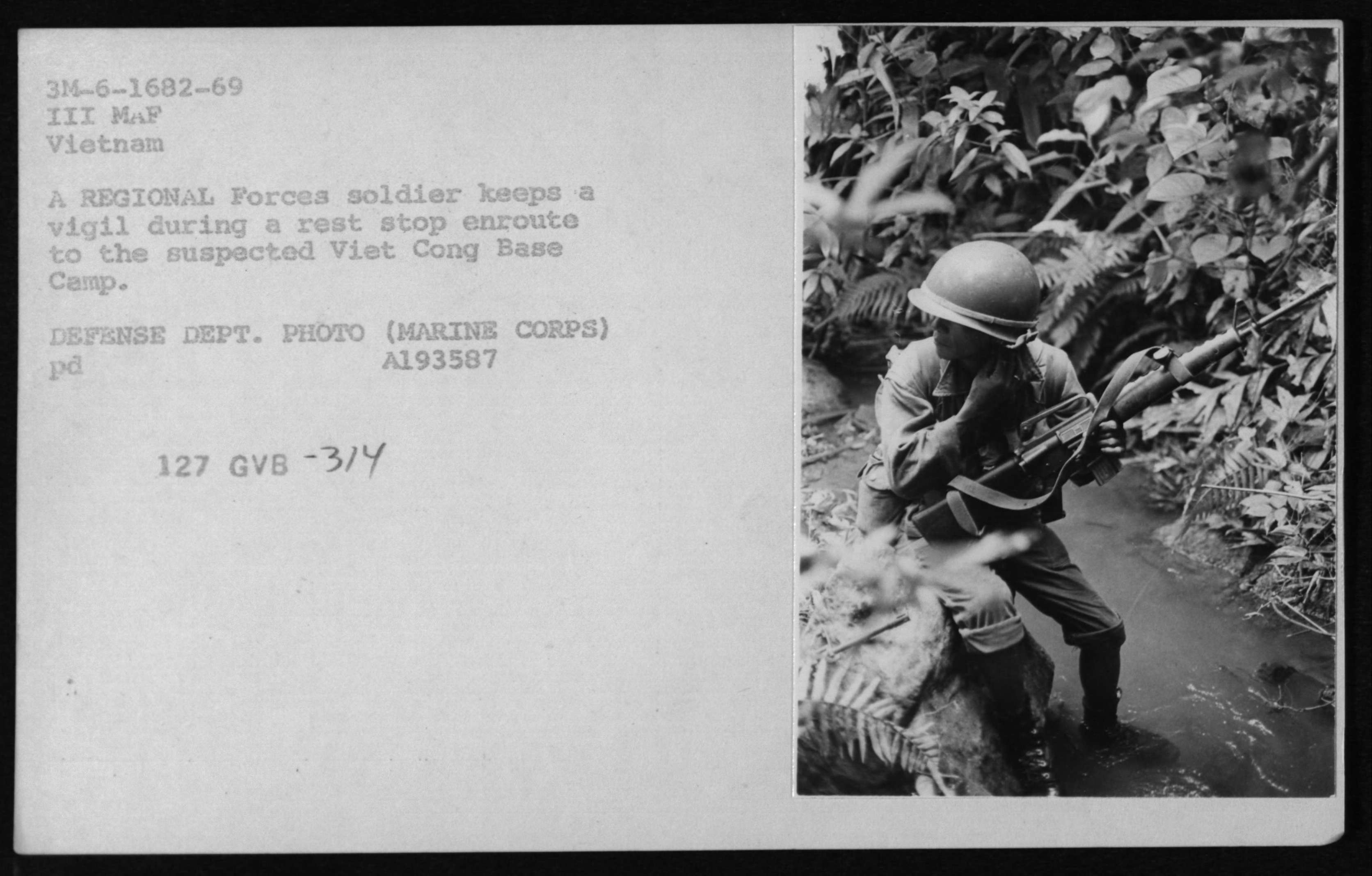
Document
313 - ARVN (Army of the Republic of Vietnam) - 1968 - July 28, 1968
7/28/1968
The original caption for this photograph reads: Waiting in ambush-- A Vietnamese Popular Force soldier and U.S. Marine, Corporal Gilbert J. Davis practice ambush techniques outside the compound of Mobile Training Team-1 near Tam Ky. The Vietnamese receive two weeks of Marine training from members of the First COmbined Action Group headquartered at Chu Lai.
This primary source comes from the Records of the U.S. Marine Corps.
National Archives Identifier: 26401614
Full Citation: Photograph 127-GVB-313-A422186; 313 - ARVN (Army of the Republic of Vietnam) - 1968 - July 28, 1968; 7/28/1968; Divider/Subject - 313 - ARVN - 1968, 1962 - 1975; Black and White Photographs of Marine Corps Activities in Vietnam, 1962 - 1975; Records of the U.S. Marine Corps, ; National Archives at College Park, College Park, MD. [Online Version, https://docsteach.org/documents/document/soldier-practice-ambush-techniques, April 19, 2024]313 - ARVN (Army of the Republic of Vietnam) - 1968 - July 28, 1968
Page 1

Document
Public Reactions: The March on the Pentagon
10/21/1967
In the late 1960s during the Vietnam War, antiwar protests mounted. Public support for the war fell below 50 percent for the first time. In October of 1967, 70,000 protesters marched on the Pentagon, the headquarters of the Department of Defense, to protest the war in Vietnam.
This photograph shows anti-war demonstrators at the reflecting pool in Washington, DC. The stereotype persists that members of the peace movement were hippies, college students, and liberal intellectual elites. In reality, there were antiwar sentiments across the political and economic spectrum.
The Johnson administration tried to tamp down dissent with news of progress, going so far as to call General Westmoreland home from the battlefield to present a glowing report to the American people. Military officers were pressured to overestimate enemy casualties and underestimate enemy strength—a practice that would have devastating consequences for President Johnson.
This photograph shows anti-war demonstrators at the reflecting pool in Washington, DC. The stereotype persists that members of the peace movement were hippies, college students, and liberal intellectual elites. In reality, there were antiwar sentiments across the political and economic spectrum.
The Johnson administration tried to tamp down dissent with news of progress, going so far as to call General Westmoreland home from the battlefield to present a glowing report to the American people. Military officers were pressured to overestimate enemy casualties and underestimate enemy strength—a practice that would have devastating consequences for President Johnson.
Transcript
Get the Hell [in small letters: icopters] out of VietnamThis primary source comes from the Collection LBJ-WHPO: White House Photo Office Collection.
National Archives Identifier: 192603
Full Citation: Photograph 7051-33; Public Reactions: The March on the Pentagon; 10/21/1967; Johnson White House Photographs, 11/22/1963 - 1/20/1969; Collection LBJ-WHPO: White House Photo Office Collection, ; Lyndon Baines Johnson Library, Austin, TX. [Online Version, https://docsteach.org/documents/document/march-on-pentagon, April 19, 2024]Public Reactions: The March on the Pentagon
Page 1
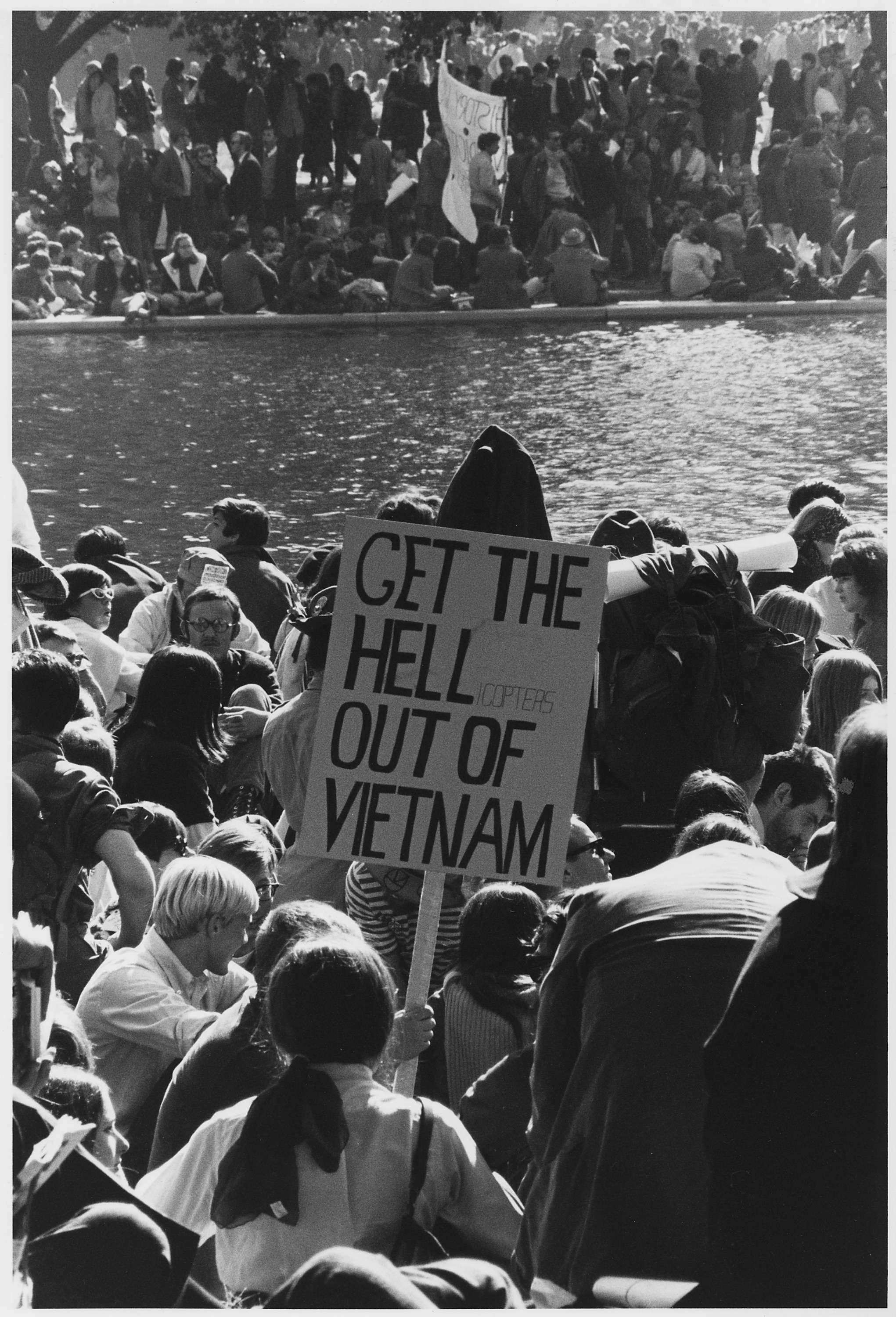
Document
Private First Class Joseph Big Medicine Jr.
7/21/1969
Private First Class Joseph Big Medicine Jr., a Cheyenne Indian, writes a letter to his family in the United States. He is a member of Company G, 2nd Battalion, 1st Marine Regiment, on a search, clear and destroy mission, seven miles east of the Marine Combat Base at An Hoa.
This primary source comes from the Records of the U.S. Marine Corps.
National Archives Identifier: 532485
Full Citation: Private First Class Joseph Big Medicine Jr.; 7/21/1969; General Photograph File of the U.S. Marine Corps, 1927 - 1981; Records of the U.S. Marine Corps, ; National Archives at College Park, College Park, MD. [Online Version, https://docsteach.org/documents/document/private-first-class-joseph-big-medicine-jr, April 19, 2024]Private First Class Joseph Big Medicine Jr.
Page 1
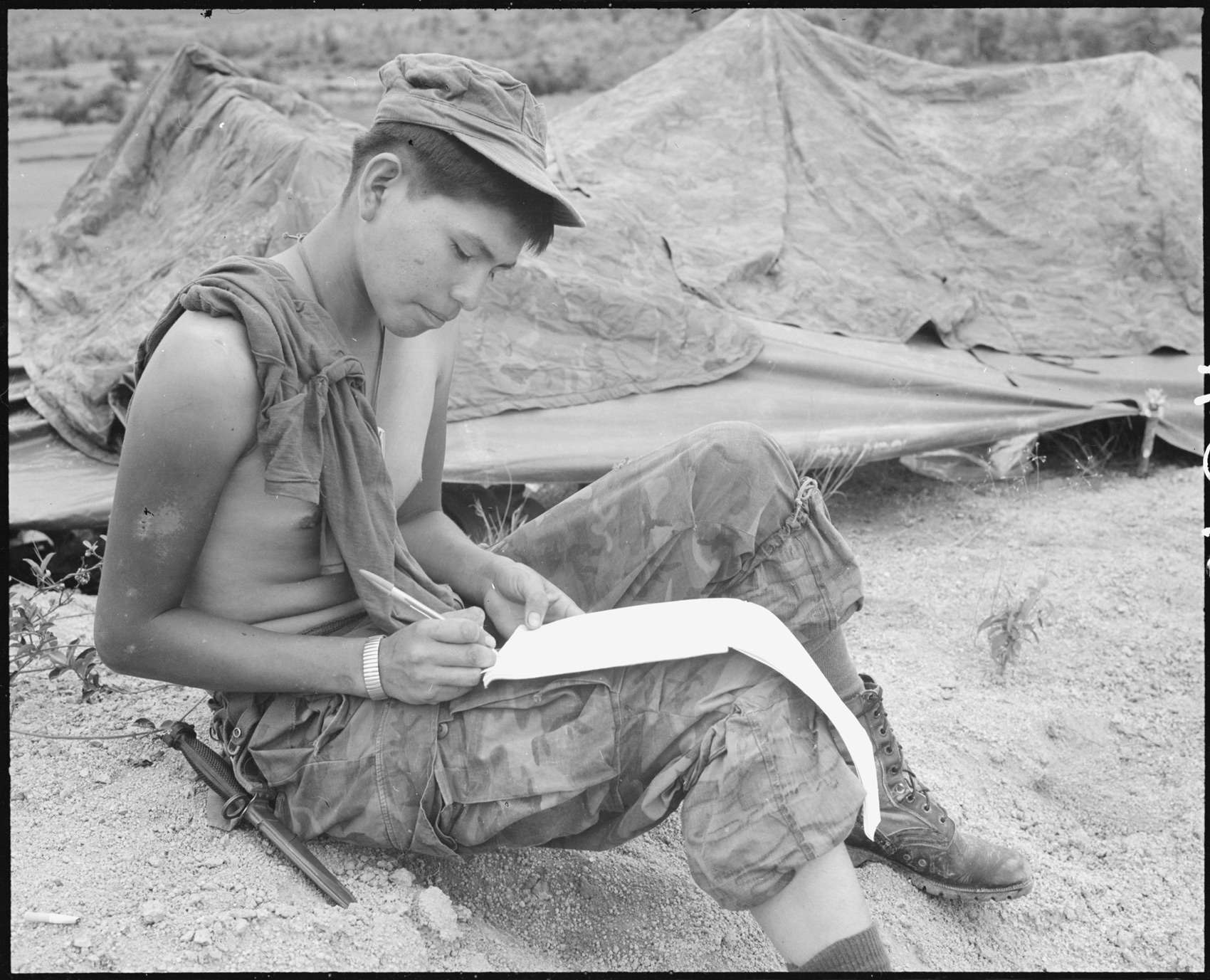
Document
State Department Telegram Text of a Letter from Ho Chi Minh to President Johnson
2/15/1967
President Johnson proposed peace talks to end the Vietnam War in February 1967. Although Ho Chi Minh had tried to initiate negotiations with the United States through third parties, he was constrained by official party policy. He wrote to President Johnson, in French, regarding the peace negotiations, and his response reflects that policy: "The Vietnamese people will never give way to force, it will never accept conversation under the clear threat of bombs."
This primary source comes from the Collection LBJ-NSF: National Security Files.
Full Citation: State Department Telegram Text of a Letter from Ho Chi Minh to President Johnson; 2/15/1967; "Sunflower" Document 43; Vietnam Country Files, 11/22/1963 - 1/20/1969; Collection LBJ-NSF: National Security Files, ; Lyndon Baines Johnson Library, Austin, TX. [Online Version, https://docsteach.org/documents/document/ho-chi-minh-to-johnson, April 19, 2024]State Department Telegram Text of a Letter from Ho Chi Minh to President Johnson
Page 1

